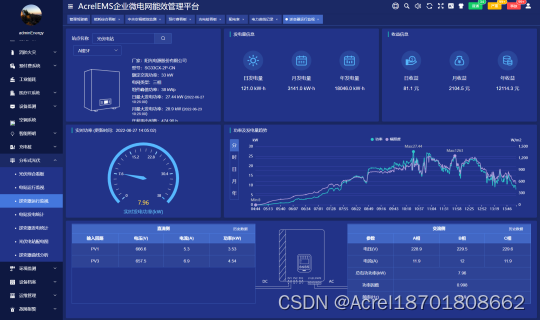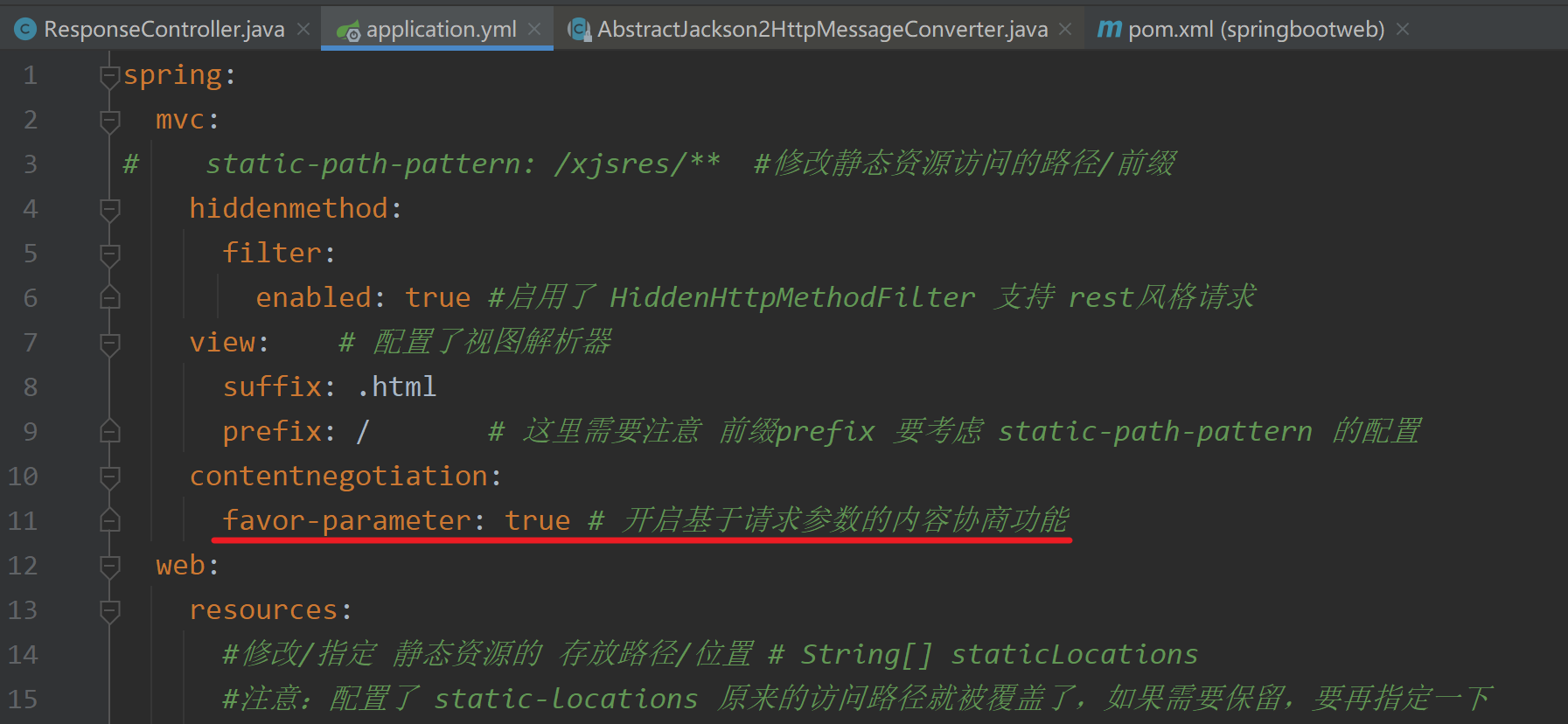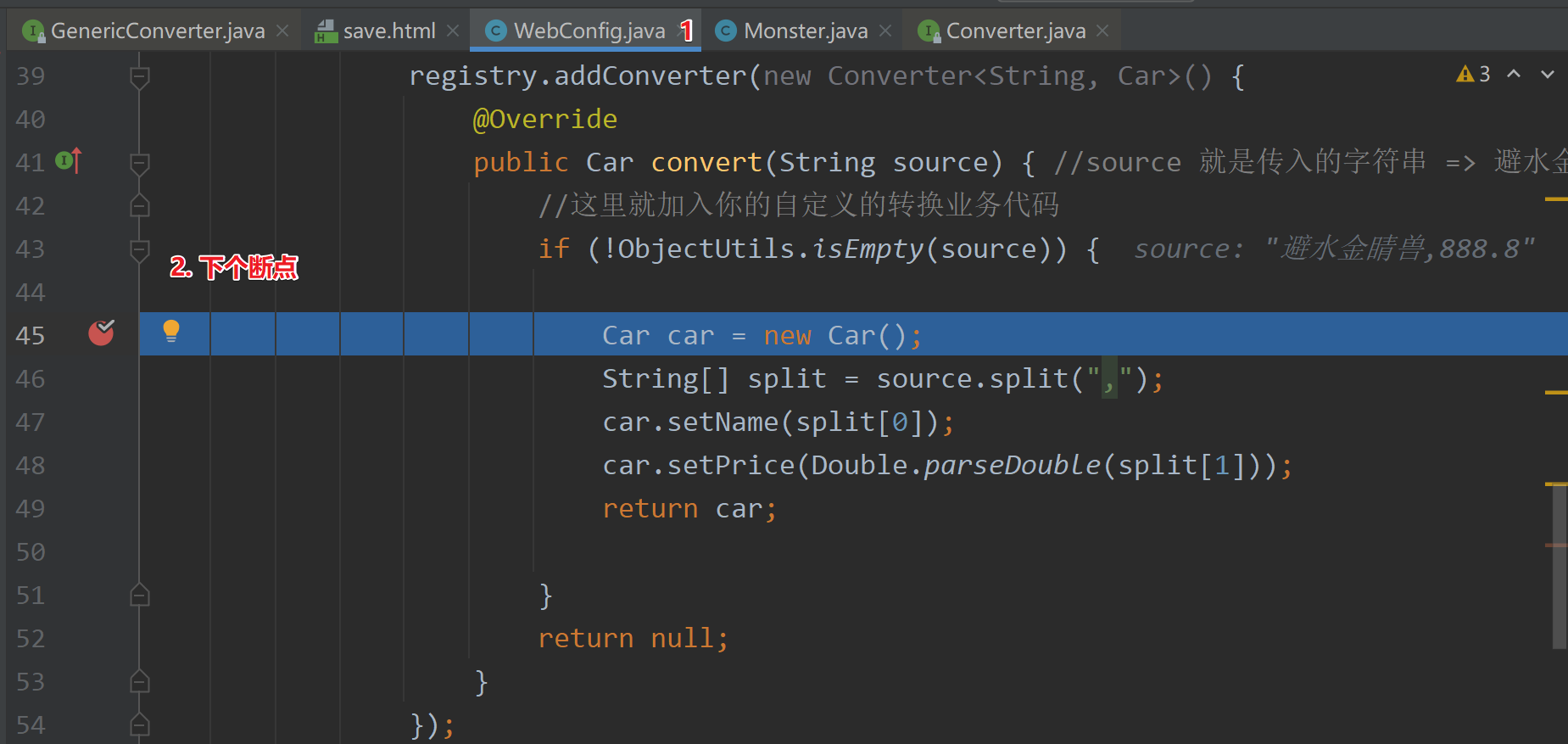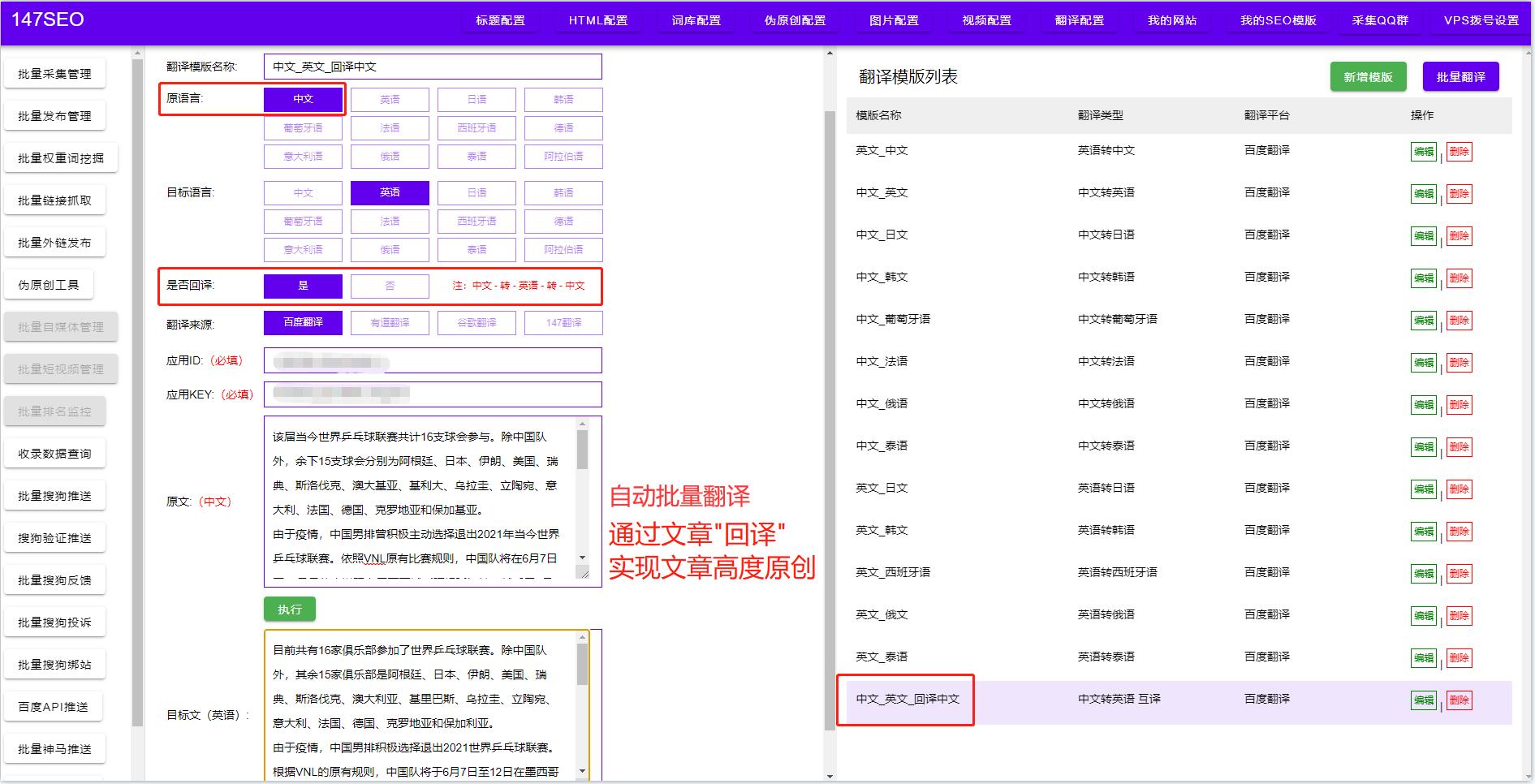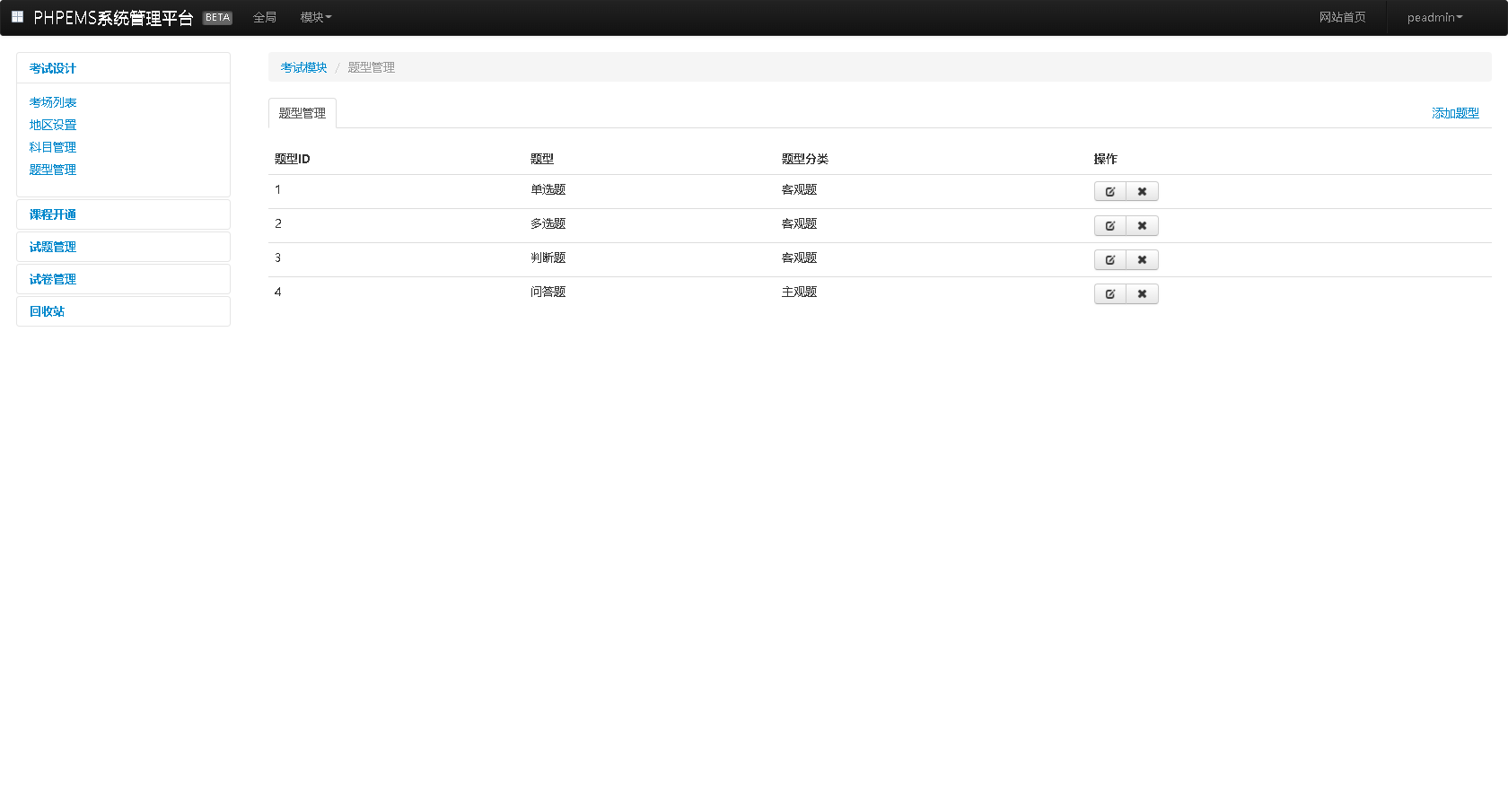当前位置:网站首页>2. Dependency management and automatic configuration
2. Dependency management and automatic configuration
2022-08-10 23:49:00 【If you want to learn, learn Big Wolf】
文章目录
2.1 依赖管理
2.1.1 什么是依赖管理
- spring-boot-starter-parent 还有父项目,声明了开发中常用的依赖的版本号
- 并且进行 自动版本仲裁,即如果程序员没有指定某个依赖 jar 的版本,The version specified by the parent project shall prevail
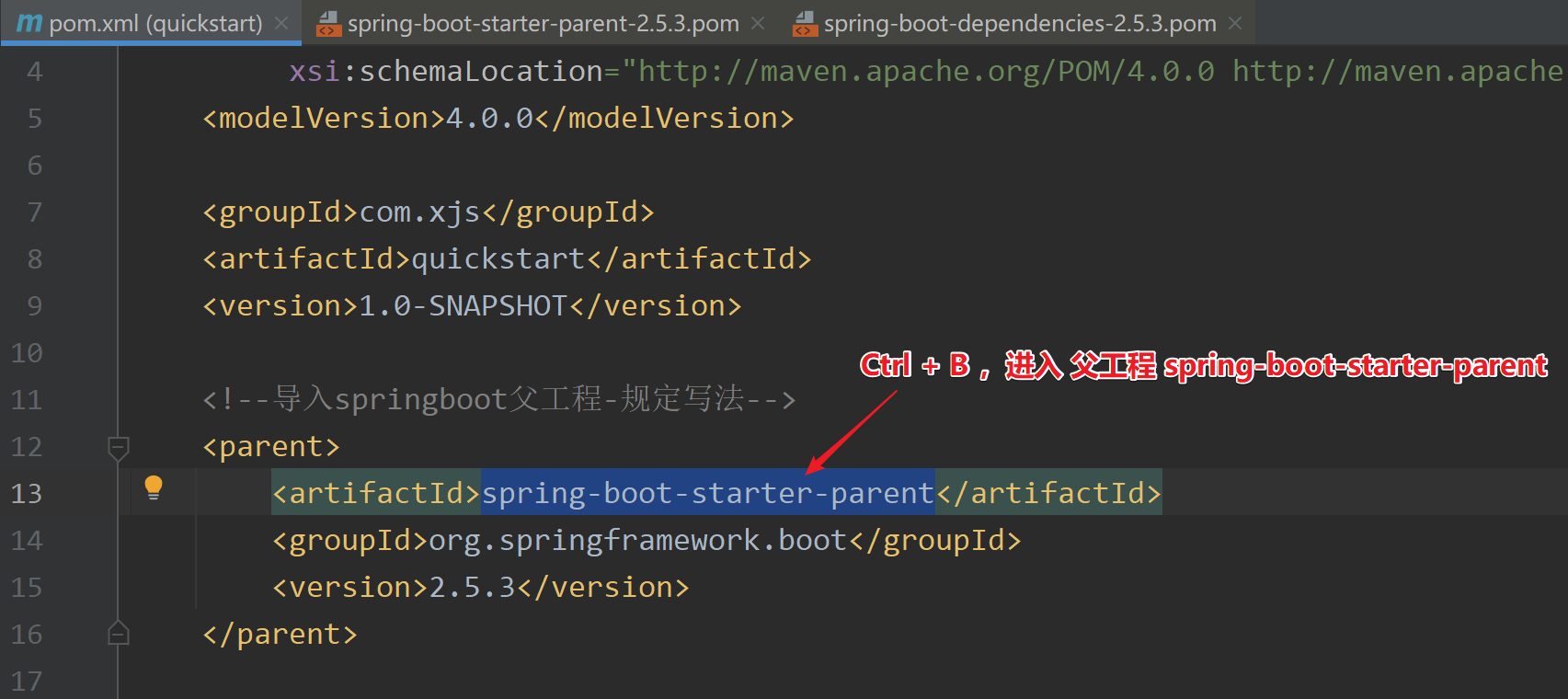
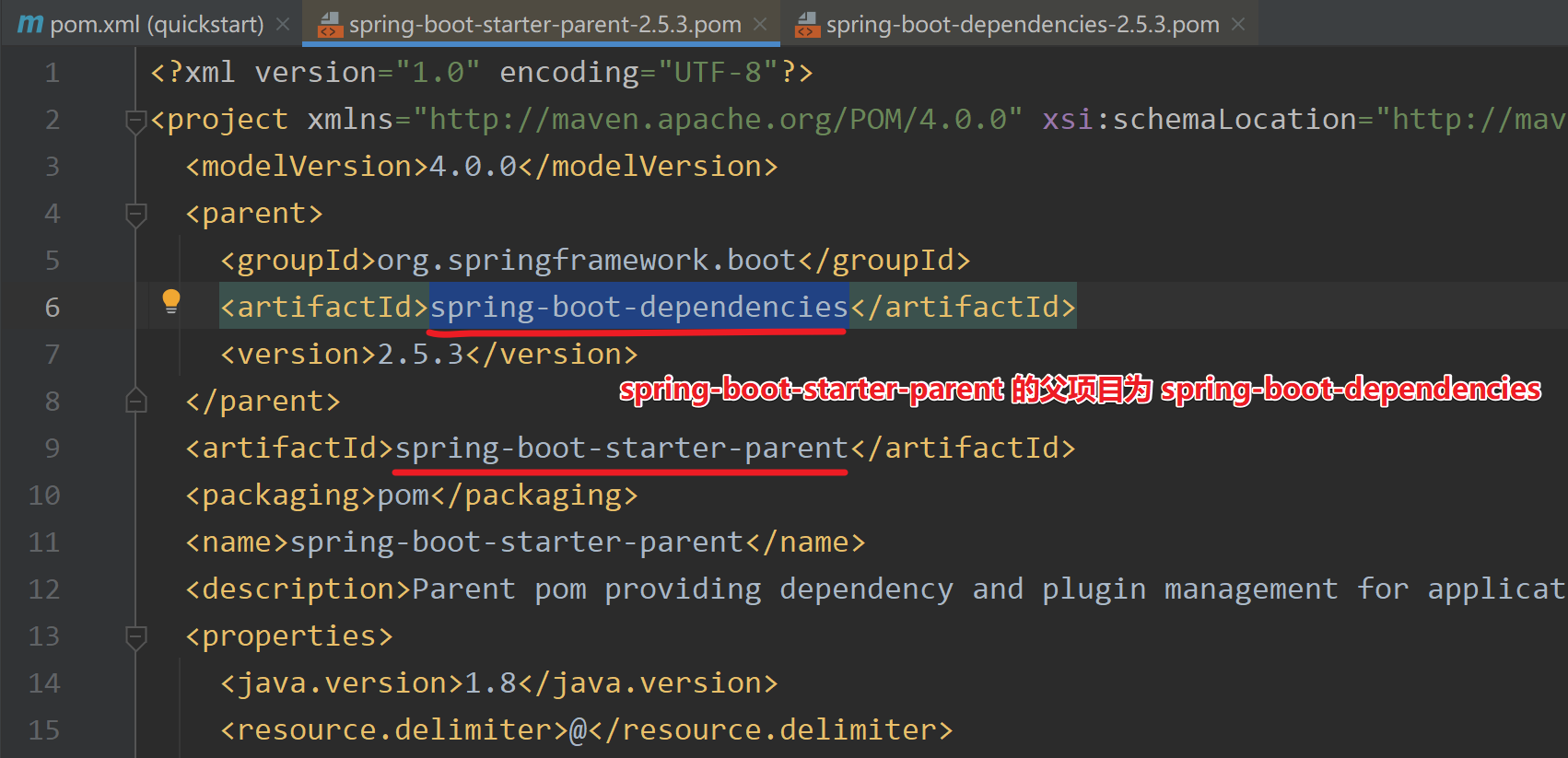
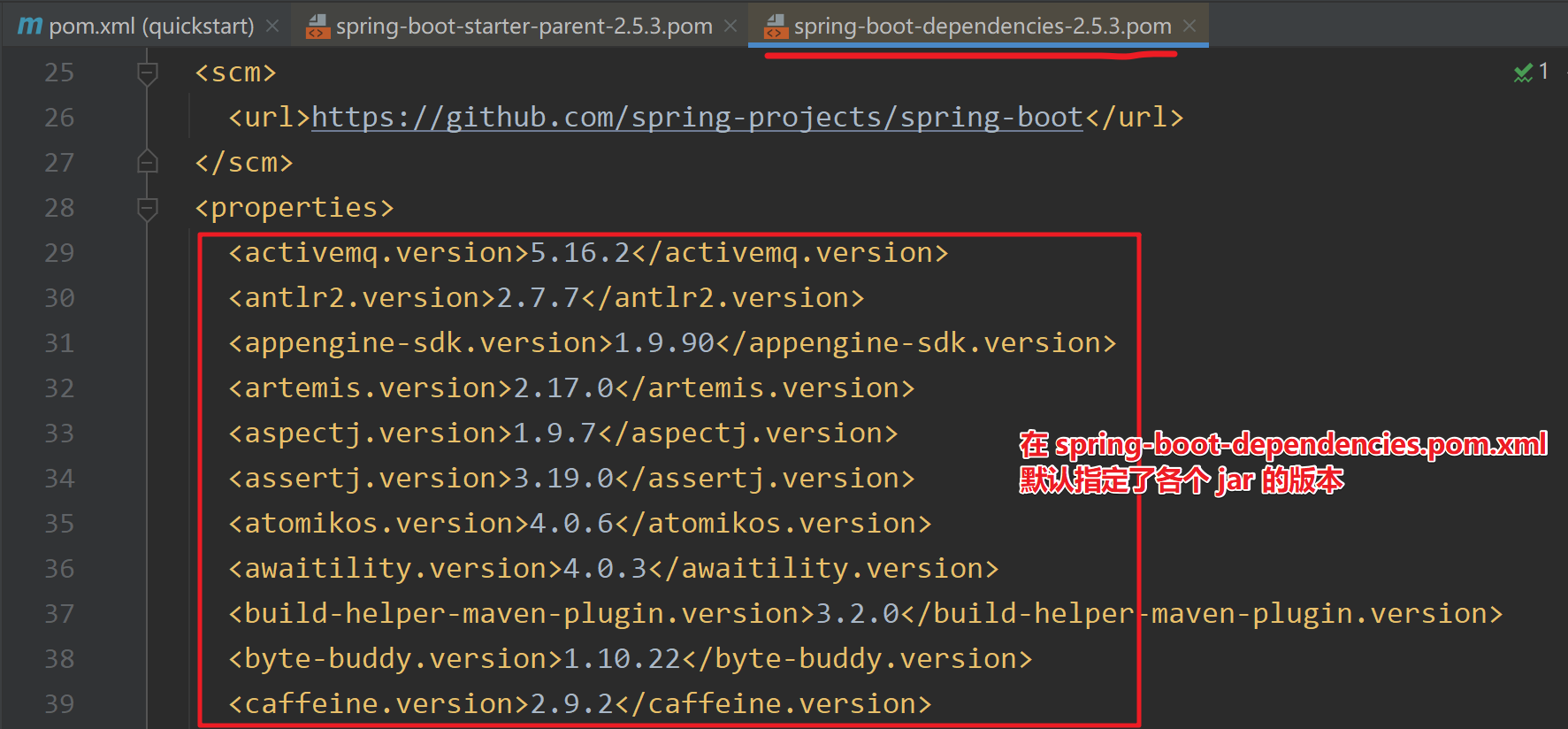
2.1.2 修改自动仲裁/默认版本号
- 需求说明:将 SpringBoot mysql 驱动修改成 5.1.49
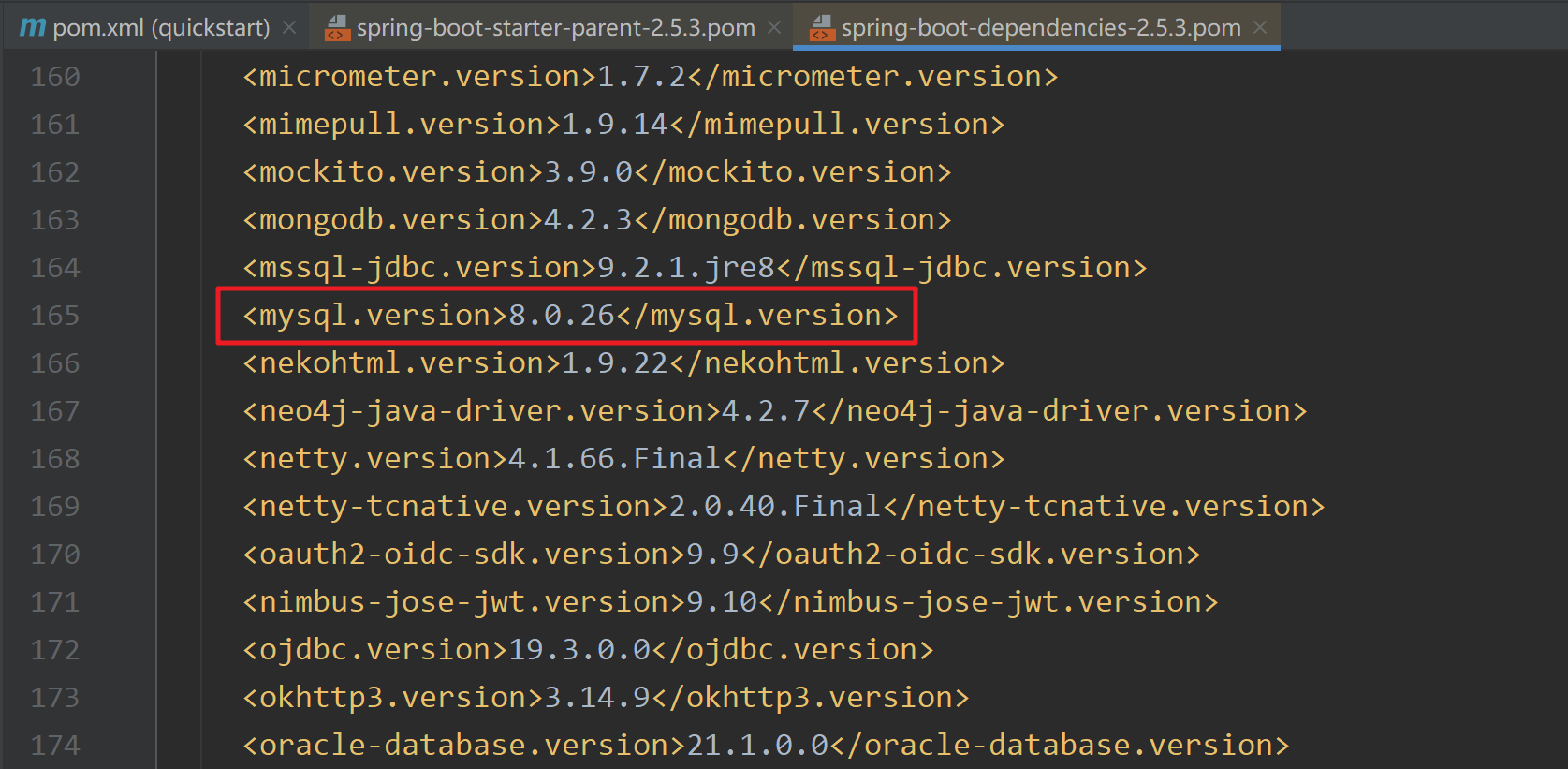
- 查看 spring-boot-dependencies.pom 里面规定当前依赖的版本 对应的 key ,这里是 mysql.version
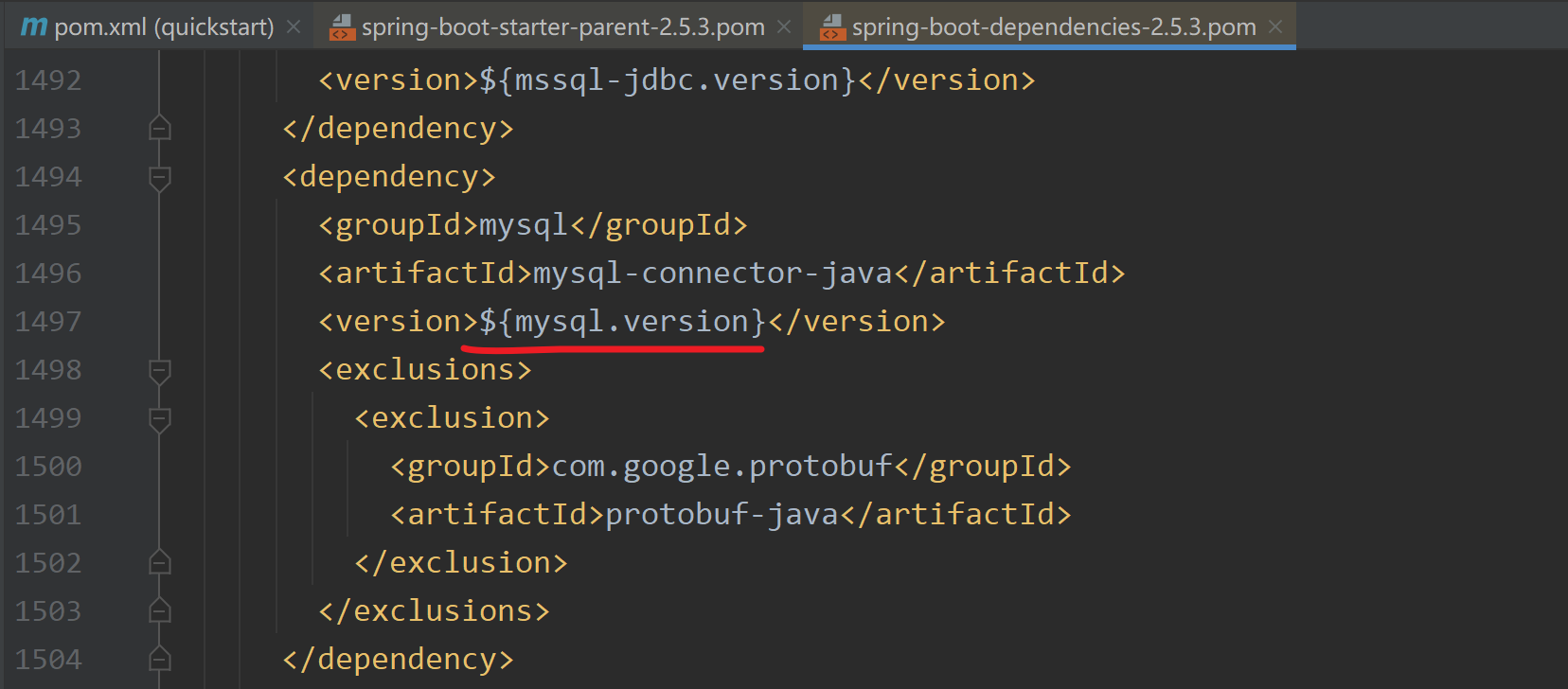
- 修改 D:\xjs_springboot\quickstart\pom.xml 重写配置,当更新 Maven 时,就依赖到新的 mysql 驱动
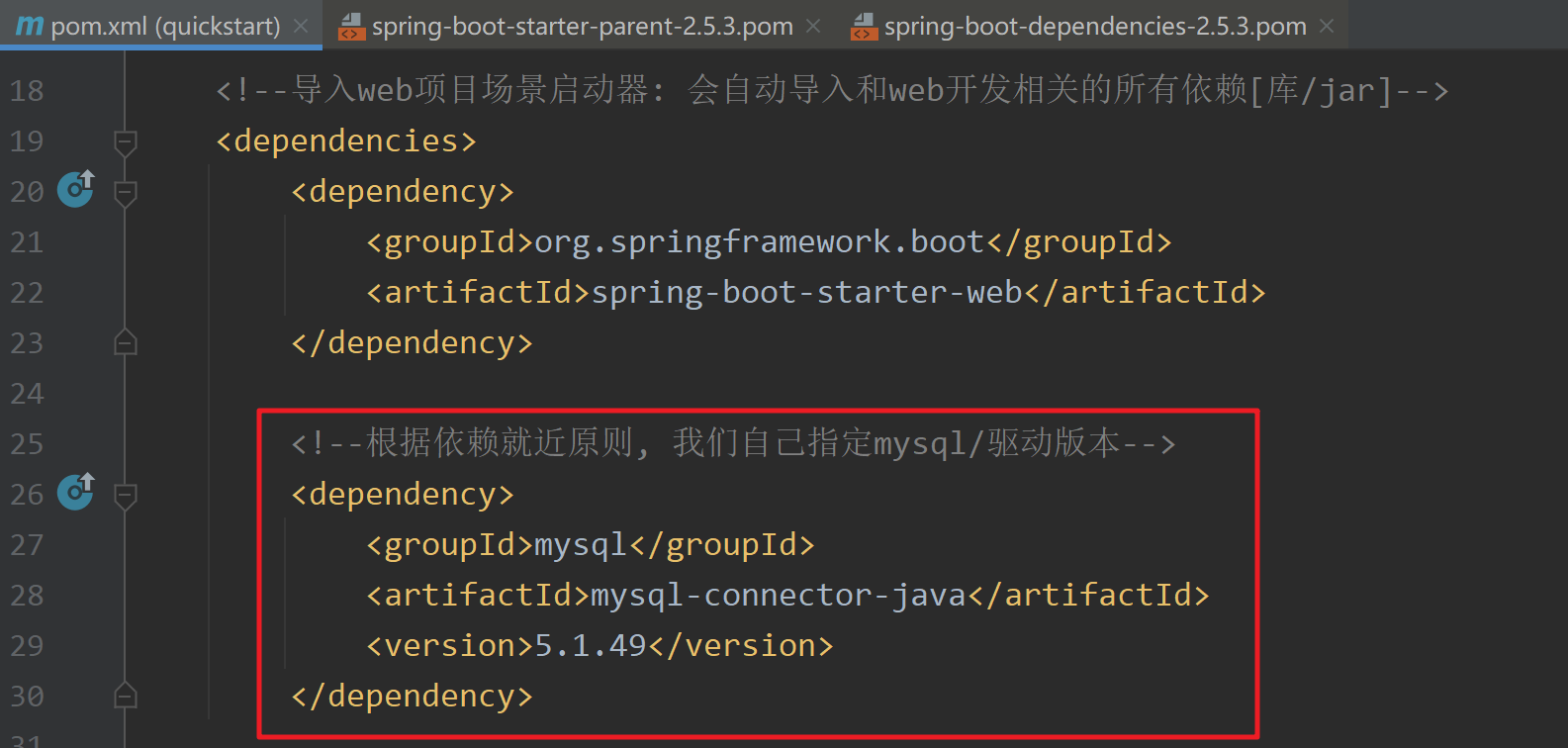
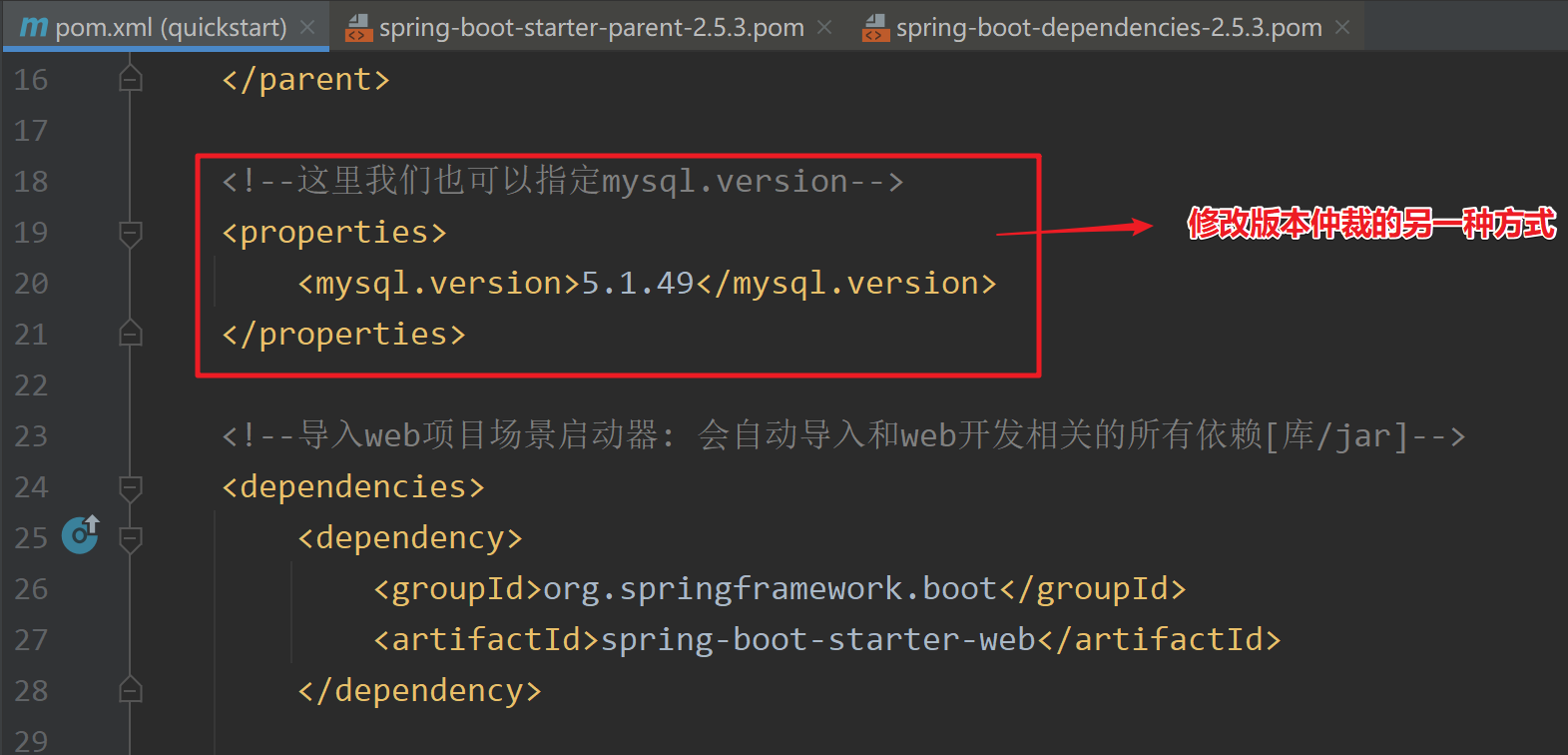
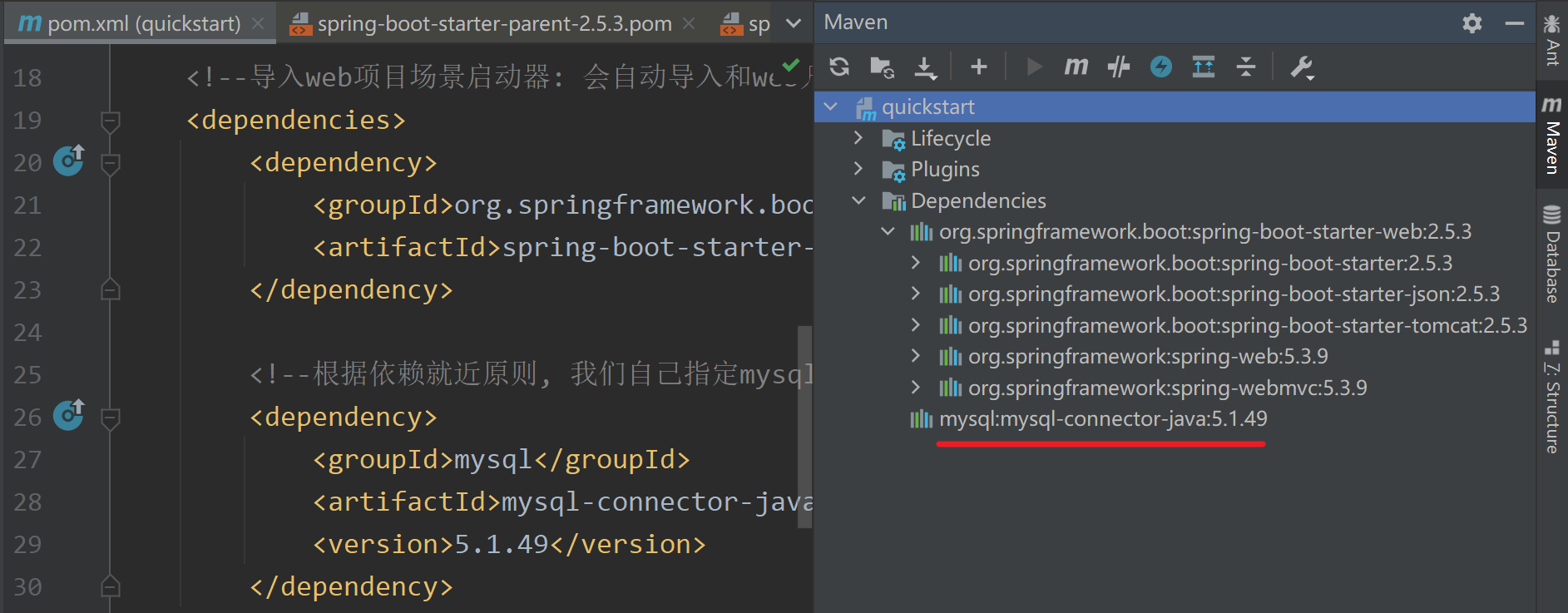
<?xml version="1.0" encoding="UTF-8"?>
<project xmlns="http://maven.apache.org/POM/4.0.0" xmlns:xsi="http://www.w3.org/2001/XMLSchema-instance" xsi:schemaLocation="http://maven.apache.org/POM/4.0.0 http://maven.apache.org/xsd/maven-4.0.0.xsd">
<modelVersion>4.0.0</modelVersion>
<groupId>com.xjs</groupId>
<artifactId>quickstart</artifactId>
<version>1.0-SNAPSHOT</version>
<!--导入springboot父工程-规定写法-->
<parent>
<artifactId>spring-boot-starter-parent</artifactId>
<groupId>org.springframework.boot</groupId>
<version>2.5.3</version>
</parent>
<!--这里我们也可以指定mysql.version-->
<properties>
<mysql.version>5.1.49</mysql.version>
</properties>
<!--导入web项目场景启动器: 会自动导入和web开发相关的所有依赖[库/jar]-->
<dependencies>
<dependency>
<groupId>org.springframework.boot</groupId>
<artifactId>spring-boot-starter-web</artifactId>
</dependency>
<!--我们自己指定mysql/驱动版本-修改版本仲裁 1. 方式一 : Show import/导入 mysql依赖,并明确的指定 <version> 2. 方式二 : 在自己的pom.xml文件中,在 <properties> 标签中指定 mysql 的 key 形如: <properties> <mysql.version>5.1.49</mysql.version> </properties> 3. Why can the effect of modifying the version arbitration be achieved: 根据依赖就近优先原则 -->
<dependency>
<groupId>mysql</groupId>
<artifactId>mysql-connector-java</artifactId>
<version>5.1.49</version>
</dependency>
</dependencies>
</project>
2.2 starter 场景启动器
2.2.1 starter 场景启动器基本介绍
- 开发中我们引入了相关场景的 starter,这个场景中所有的相关依赖都引入进来了,比如我们做 web 开发引入了,该 starter 将导入与 web 开发相关的所有包
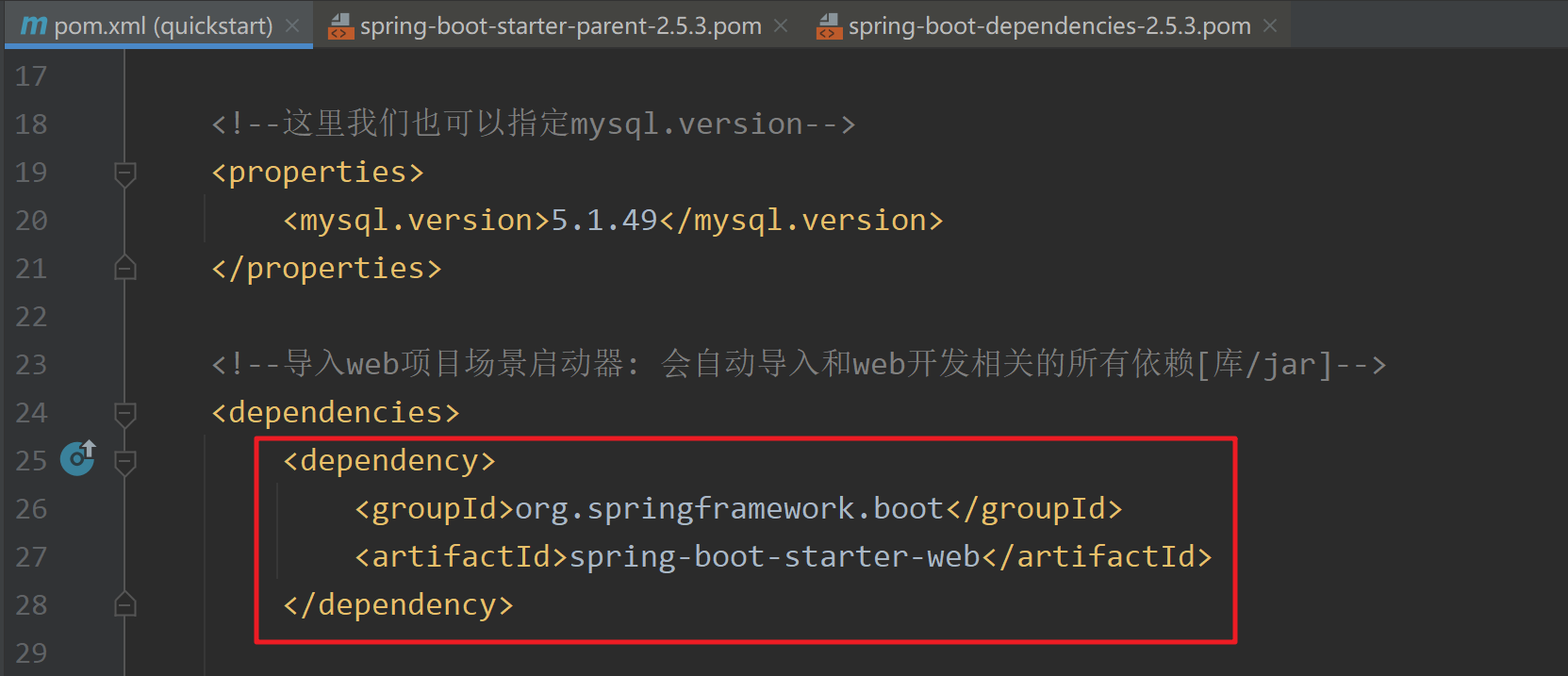

- 依赖树:可以看到 spring-boot-starter-web ,帮我们引入了 spring-webmvc,spring-web 开发模块,还引入了 spring-boot-starter-tomcat 场景,spring-boot-starter-json 场景,这些场景下面又引入了一大堆相关的包,这些依赖项可以快速启动和运行一个项目,提高开发效率
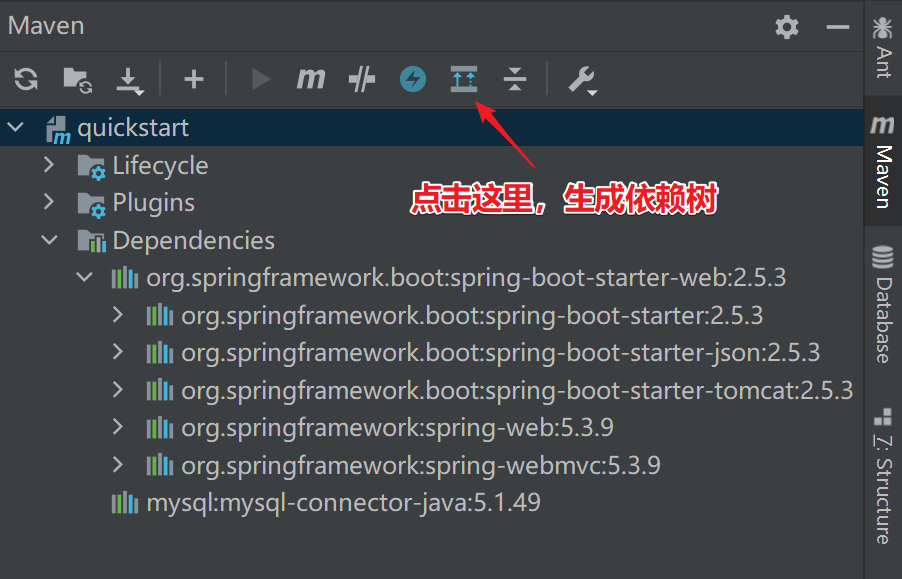
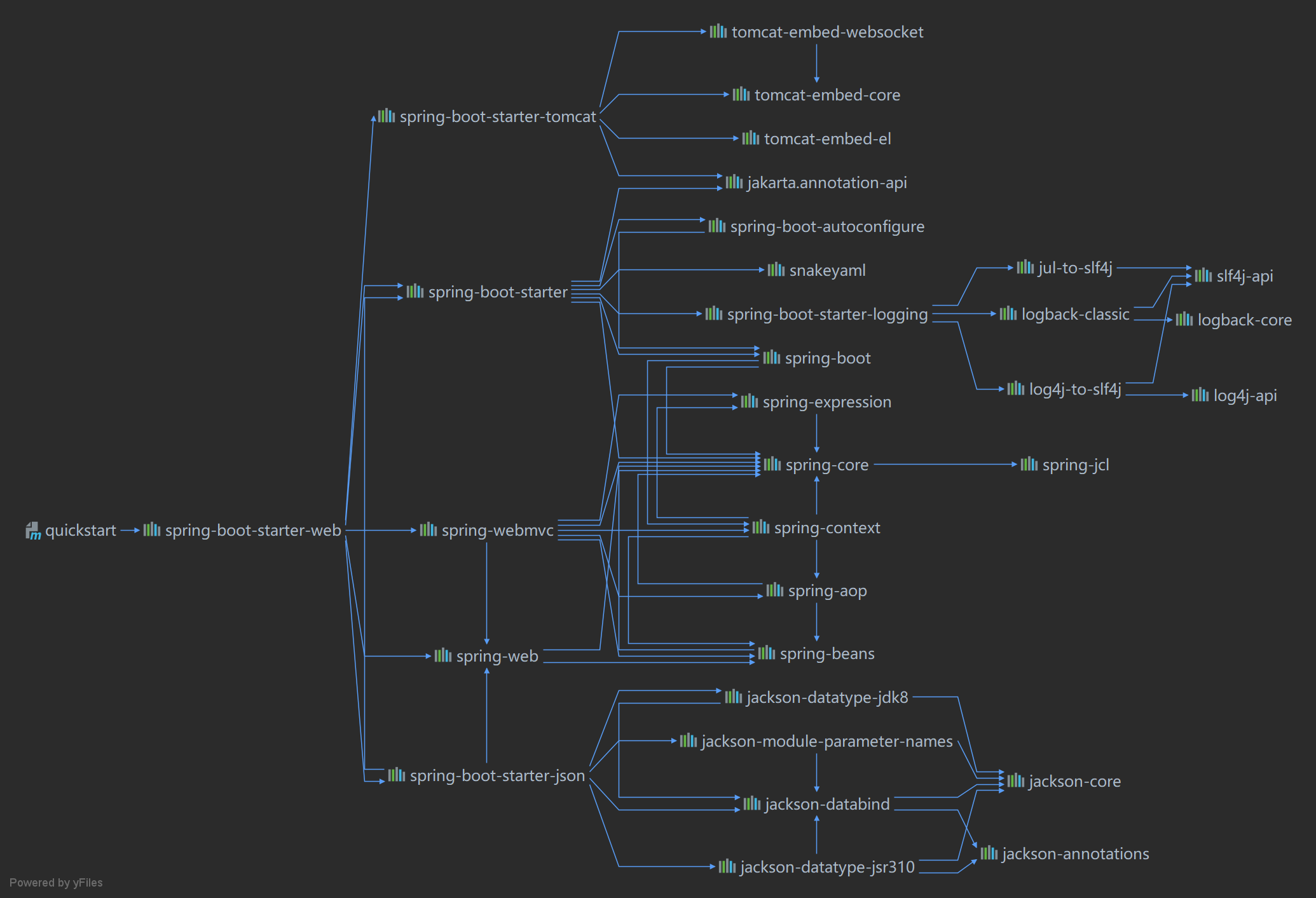
- 所有场景启动器最基本的依赖就是 spring-boot-starter ,前面的依赖树分析可以看到,这个依赖也就是 SpringBoot 自动配置的核心依赖
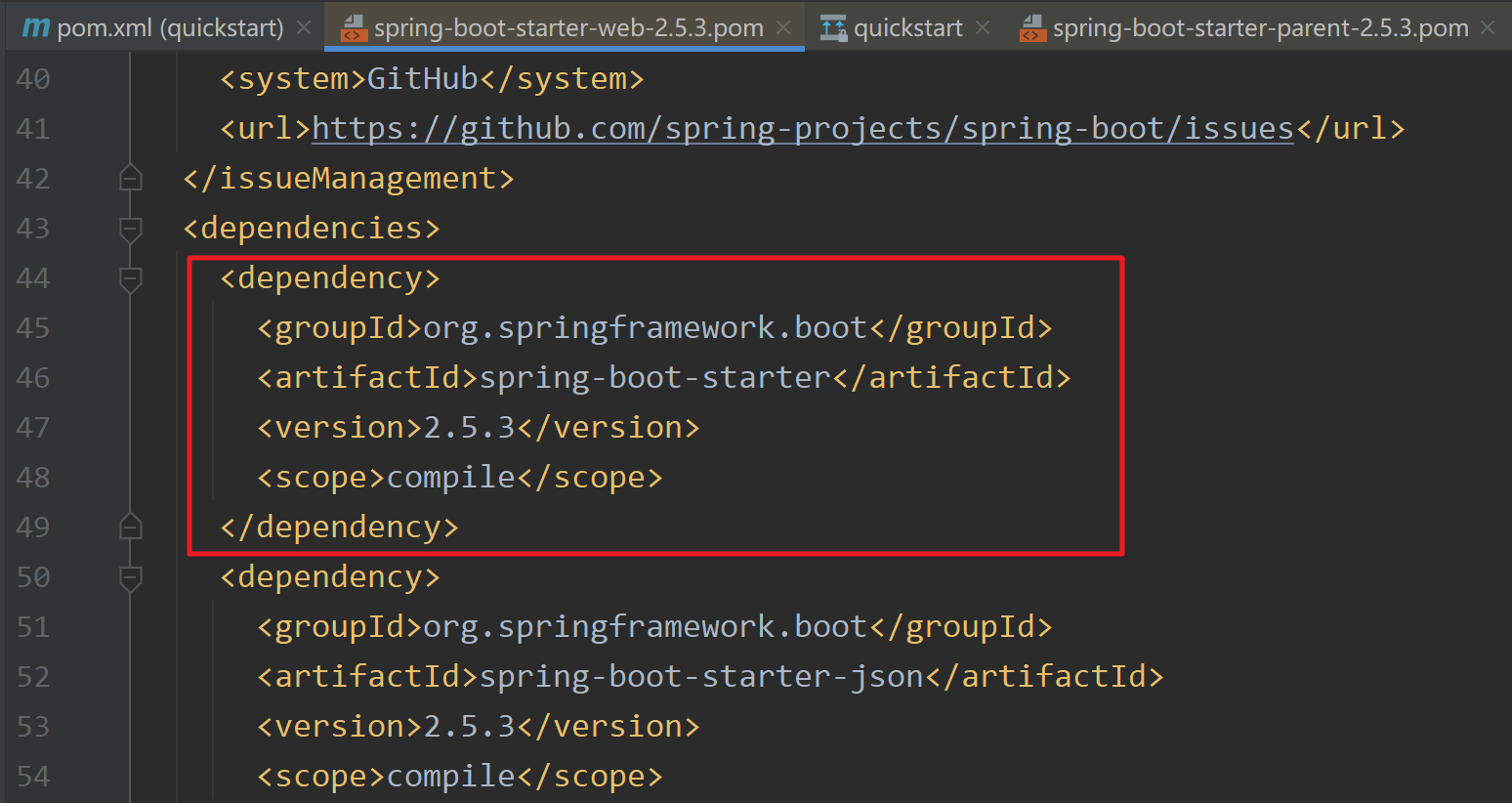
2.2.2 官方提供的 starter
2.2.2.1 地址
2.2.2.2 介绍
- 在开发中我们经常会用到 spring-boot-starter-xxx ,比如 spring-boot-starter-web,该场景是用作 web 开发,也就是说 xxx 是某种开发场景
- 我们只要引入 starter,这个场景的所有常规需要的依赖我们都自动引入
2.2.3 第三方 starter
- SpringBoot 也支持第三方 starter
- 第三方 starter 不要从 spring-boot 开始,因为这是官方 spring-boot 保留的命名方式的
- 第三方启动程序通常以项目名称开头.例如,名为 thirdpartyproject 的第三方启动程序项目通常被命名为 thirdpartyproject-spring-boot-starter
- 也就是说:xxx-spring-boot-starter 是第三方为我们提供的简化开发的场景启动器
2.3 自动配置
2.3.1 自动配置基本介绍
- 前面学习 SSM 整合时,需要配置 Tomcat 、配置 SpringMVC、Configure how to scan packages、配置字符过滤器、配置视图解析器、文件上传等[如图],非常麻烦…
- 而在 SpringBoot 中,存在 自动配置机制 ,提高开发效率
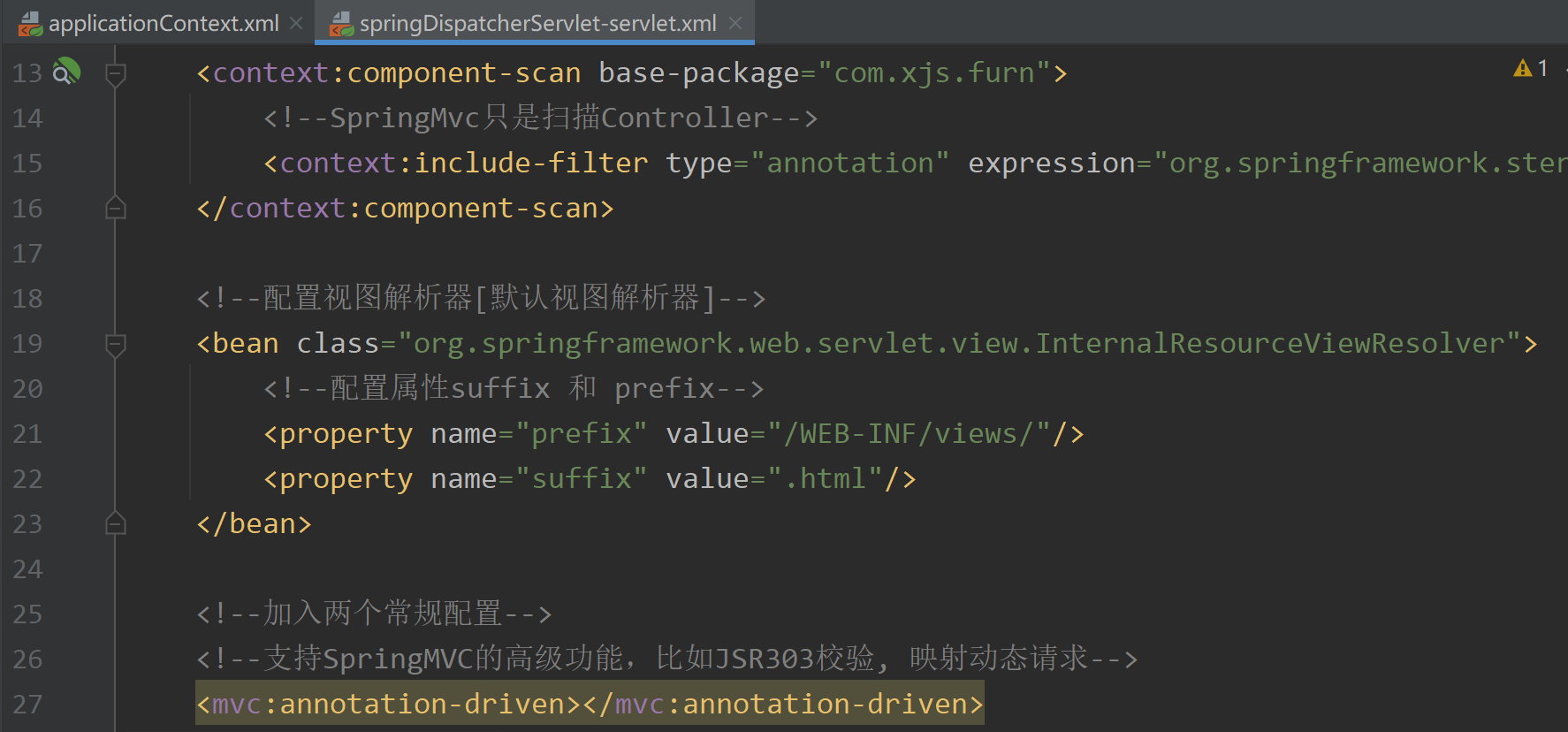
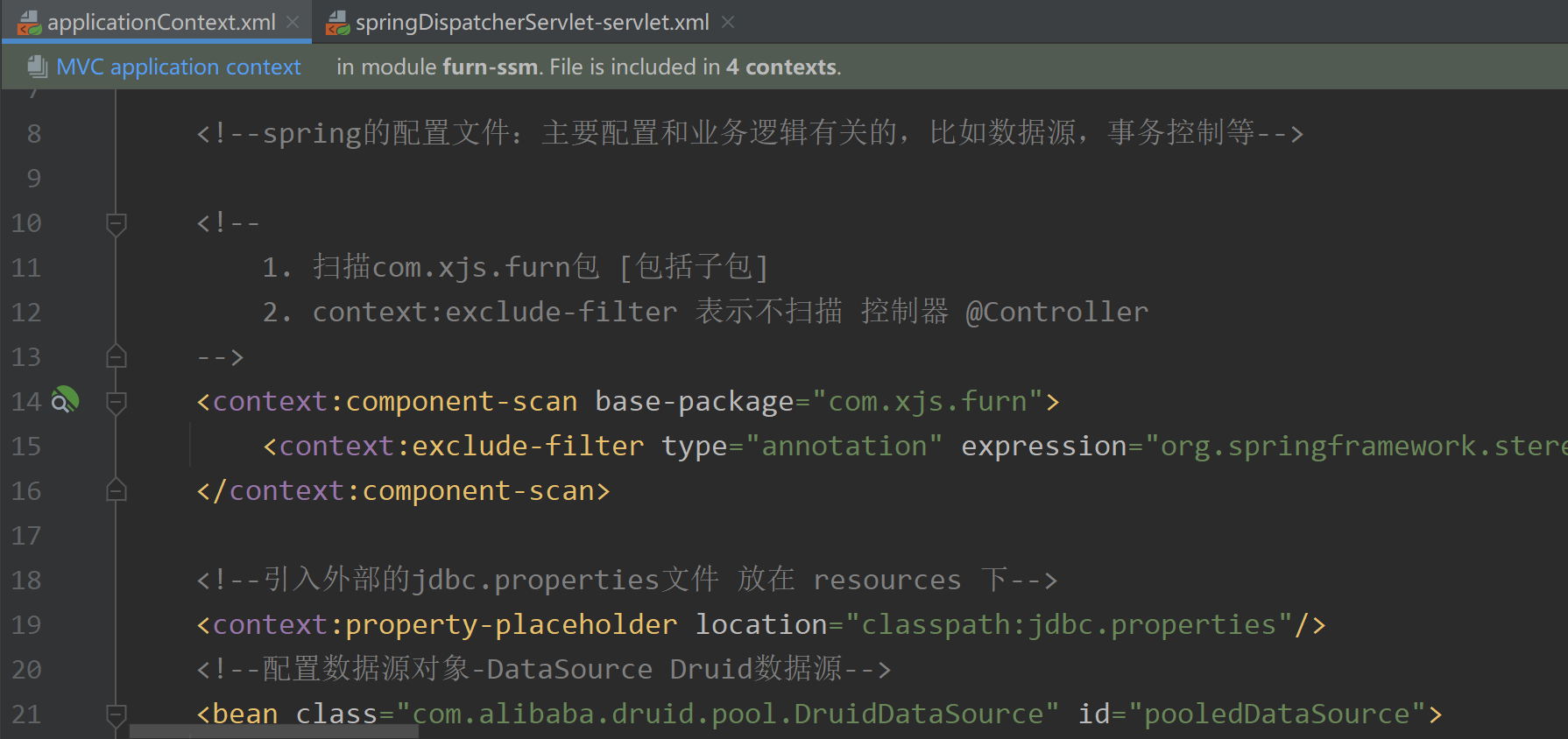
2.3.2 SpringBoot 自动配置了哪些?
- 自动配置 Tomcat
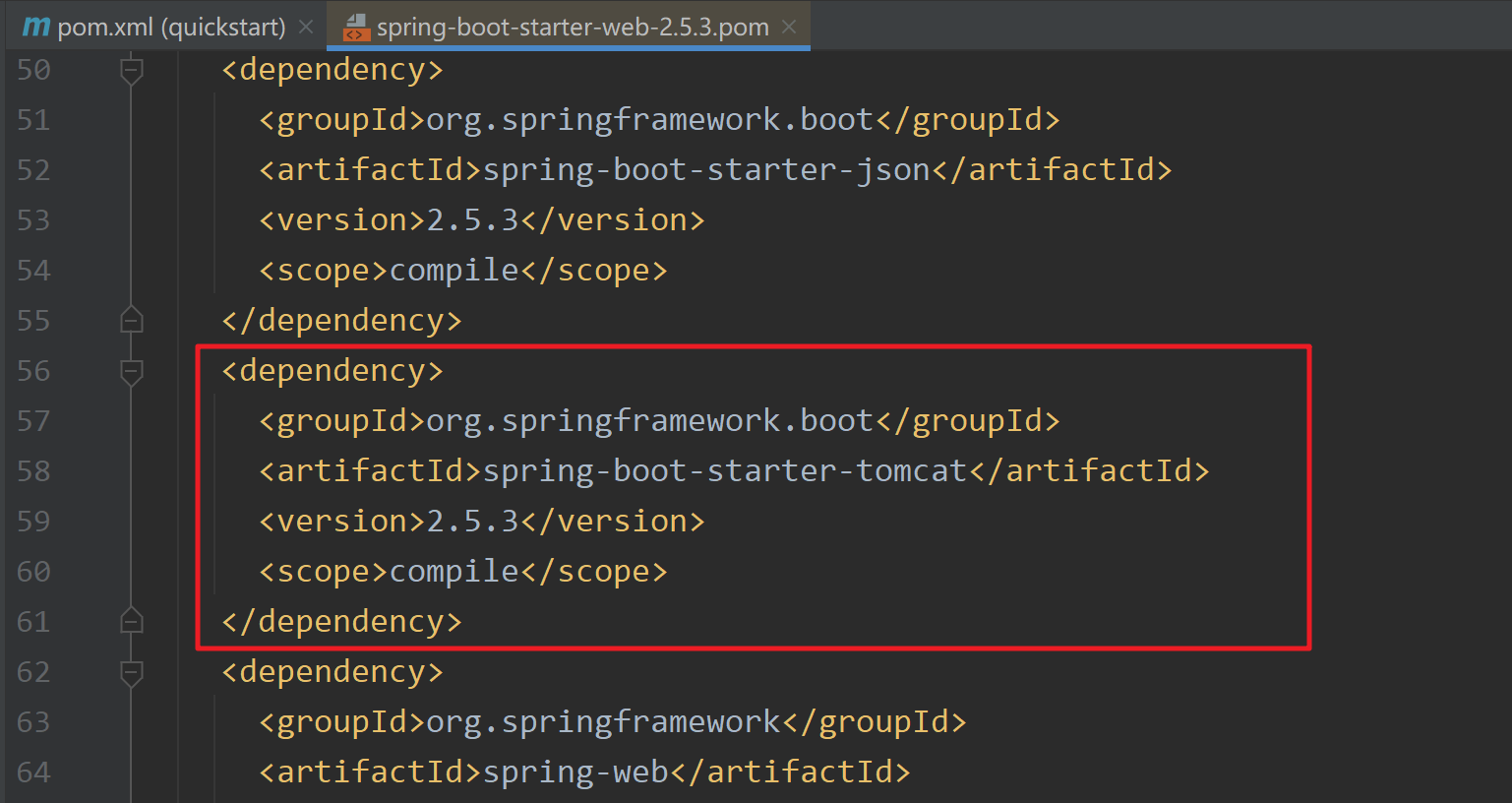
- 自动配置 SpringMVC
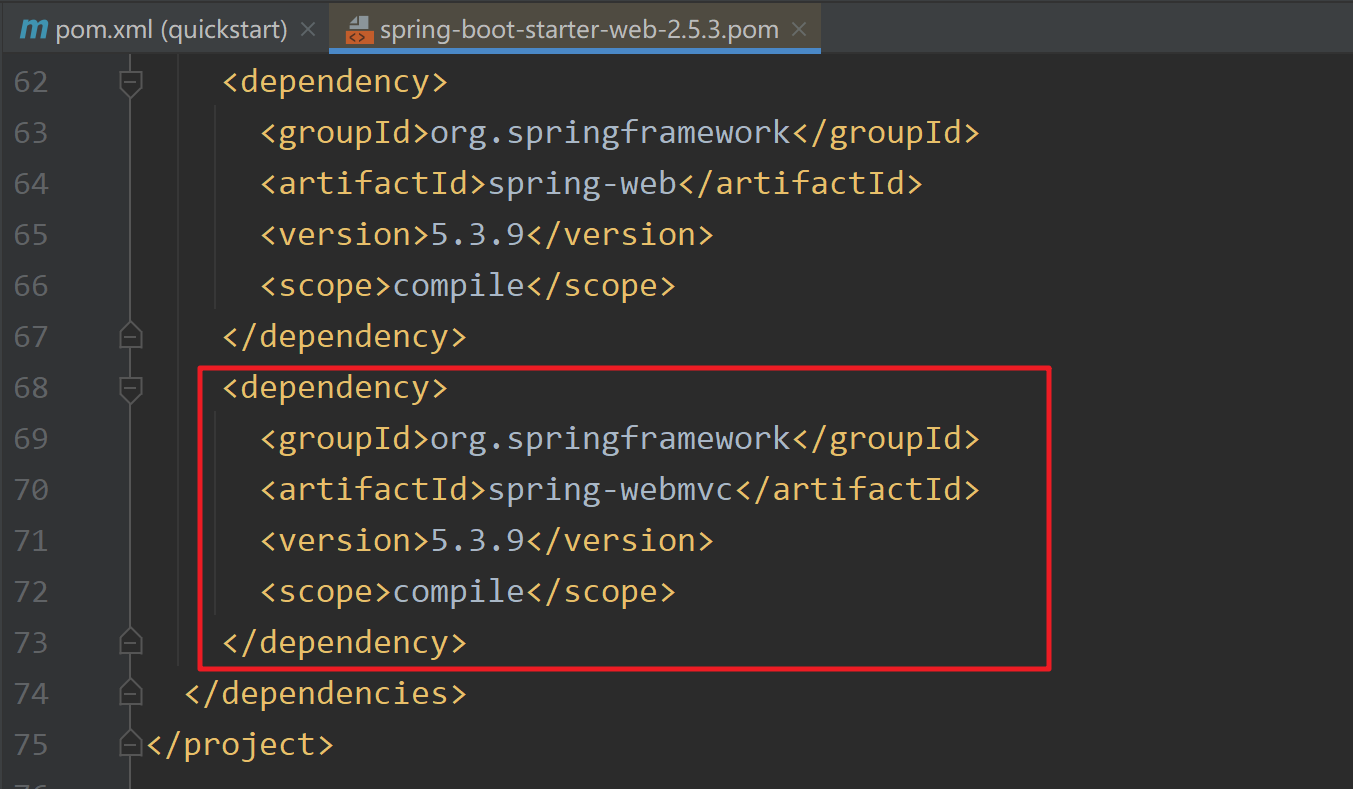
- 自动配置 Web 常用功能:比如字符过滤器,特别提示:通过获取 ioc 容器,Check out the components created by the container to verify,修改 D:\xjs_springboot\quickstart\src\main\java\com\xjs\springboot\MainApp.java
package com.xjs.springboot;
import org.springframework.boot.SpringApplication;
import org.springframework.boot.autoconfigure.SpringBootApplication;
import org.springframework.context.ConfigurableApplicationContext;
/** * @Author: 谢家升 * @Version: 1.0 * * @SpringBootApplication : 表示这是一个 springboot应用/项目 */
@SpringBootApplication
public class MainApp {
public static void main(String[] args) {
//启动springboot应用程序/项目
ConfigurableApplicationContext ioc = SpringApplication.run(MainApp.class, args);
//How to view injected components in container
String[] beanDefinitionNames = ioc.getBeanDefinitionNames();
for (String beanDefinitionName : beanDefinitionNames) {
System.out.println("beanDefinitionName= " + beanDefinitionName);
}
}
}
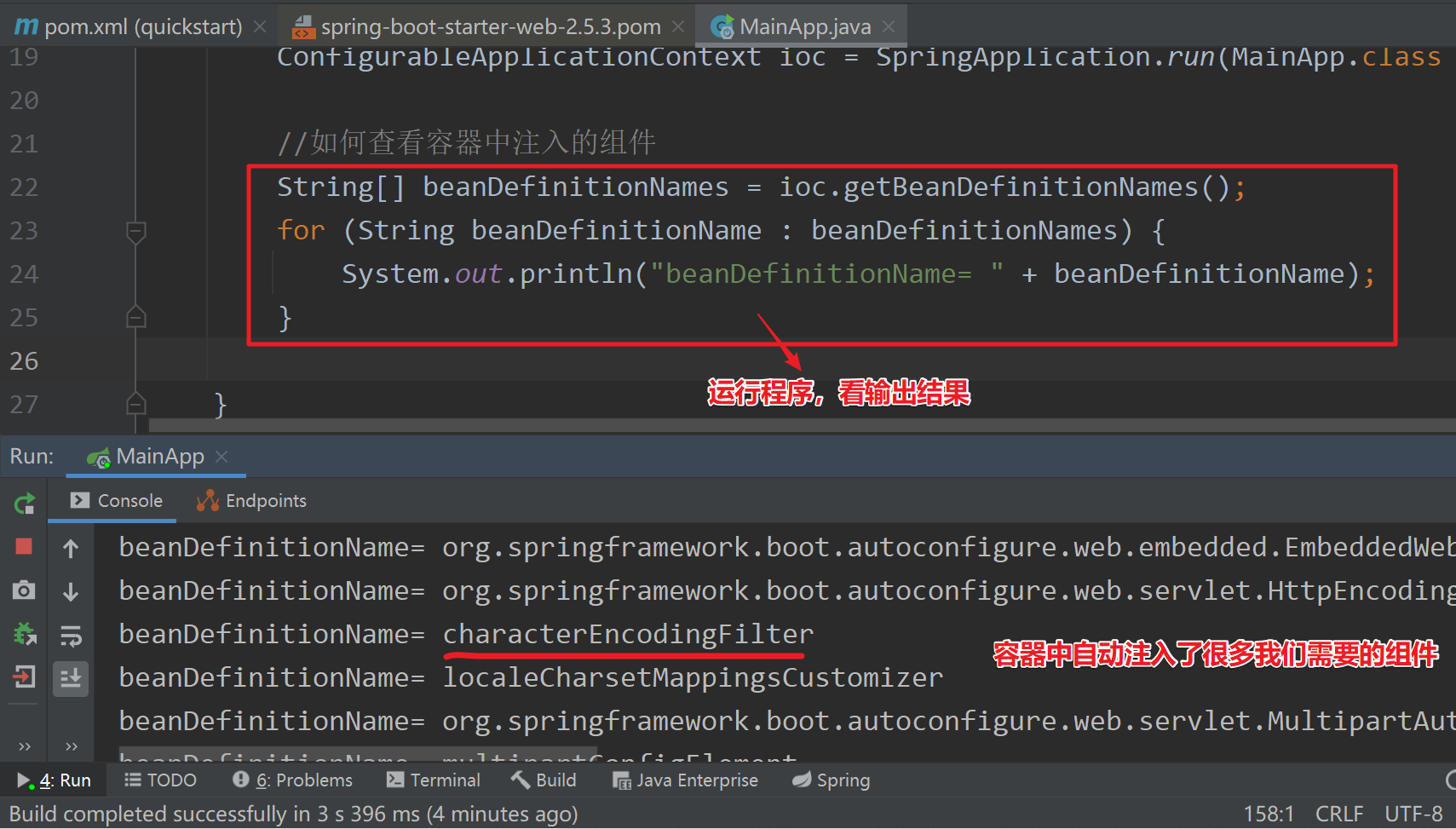
-----也可以通过debug,看的更加清晰-----
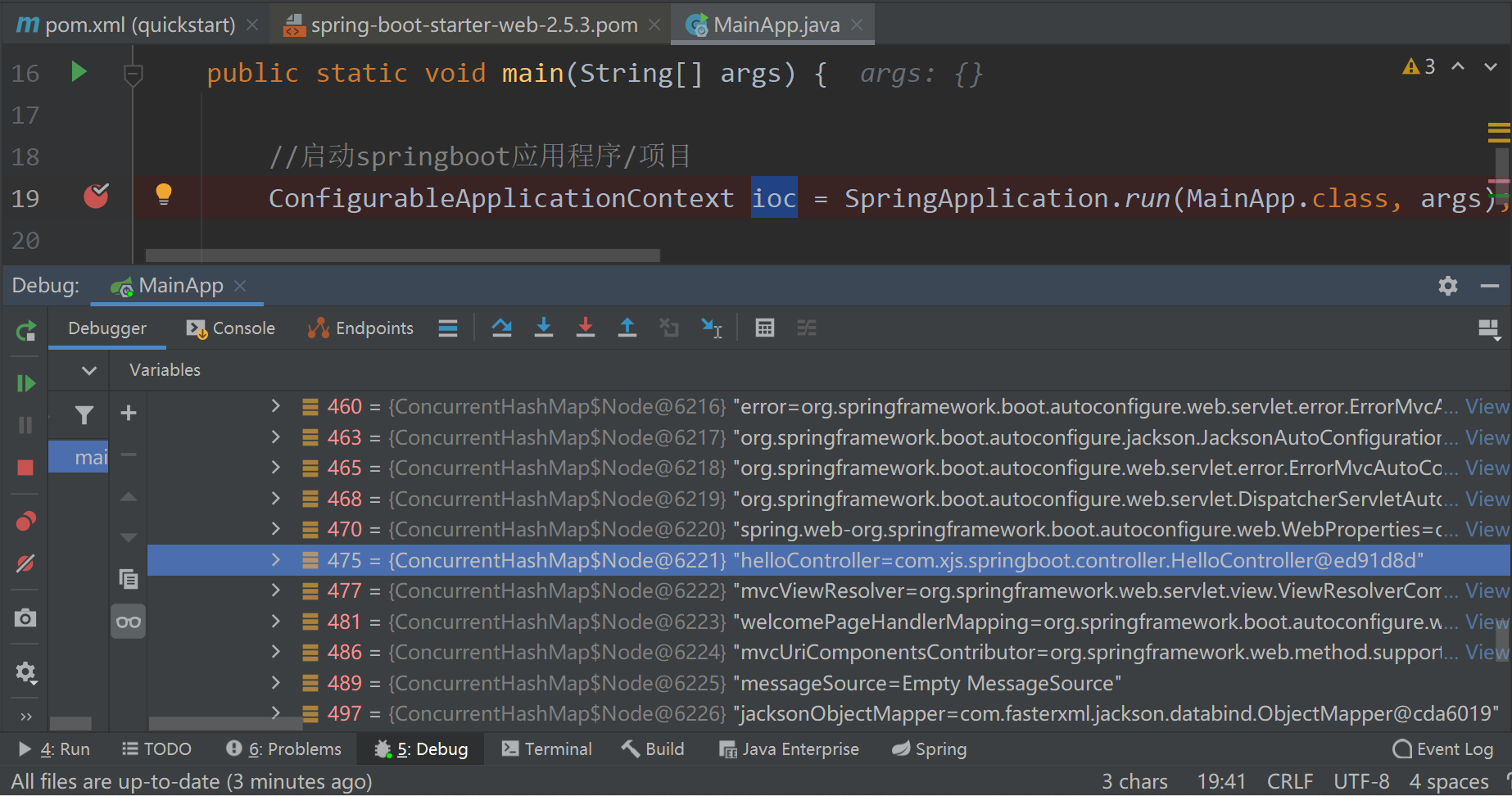
- 自动配置:默认扫描包结构 ==> 官方文档
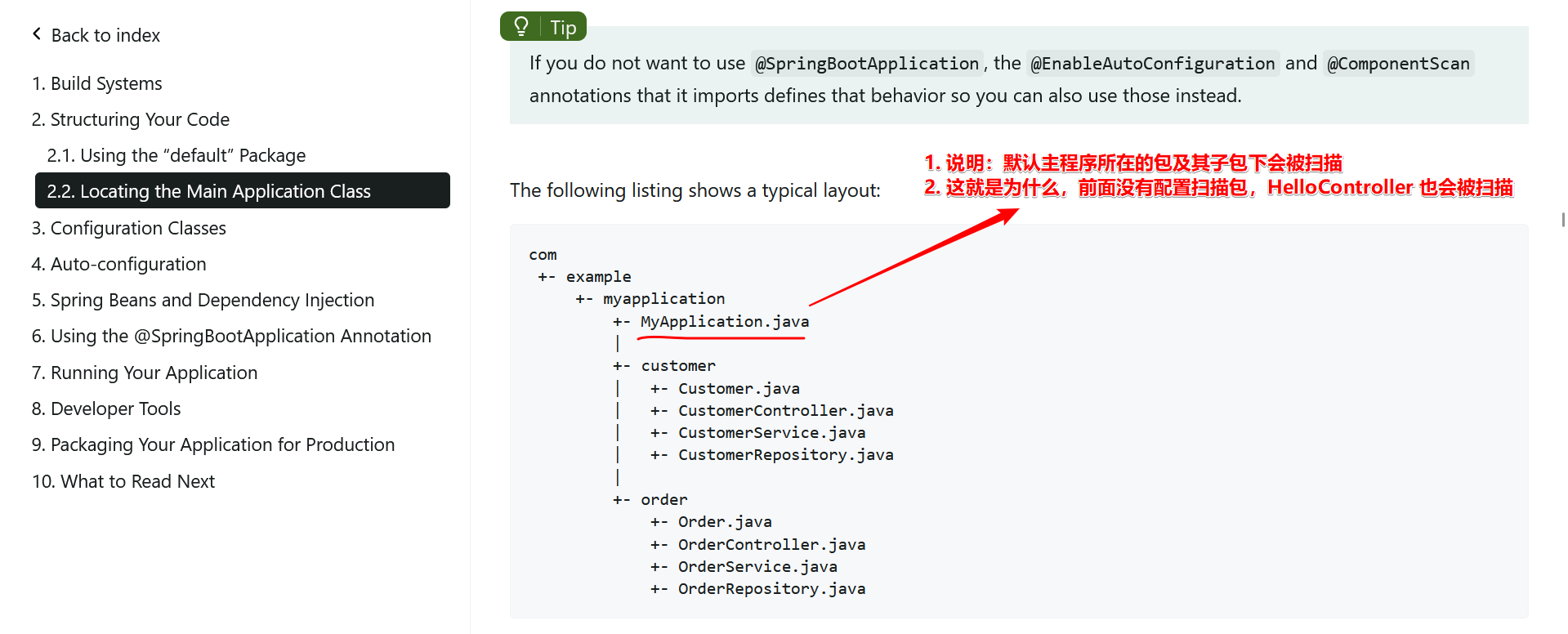
2.3.3 如何修改默认配置
2.3.3.1 如何修改默认扫描包结构
- 需求:要求能扫描 com.xjs 包下的 HiController.java 应该如何处理?
- 创建:D:\xjs_springboot\quickstart\src\main\java\com\xjs\HiController.java ,并测试,It is not accessible at this time
package com.xjs;
import org.springframework.stereotype.Controller;
import org.springframework.web.bind.annotation.RequestMapping;
import org.springframework.web.bind.annotation.ResponseBody;
/** * @Author: 谢家升 * @Version: 1.0 */
@Controller
public class HiController {
@RequestMapping("/hi")
@ResponseBody
public String hi() {
return "hi~, SpringBoot";
}
}
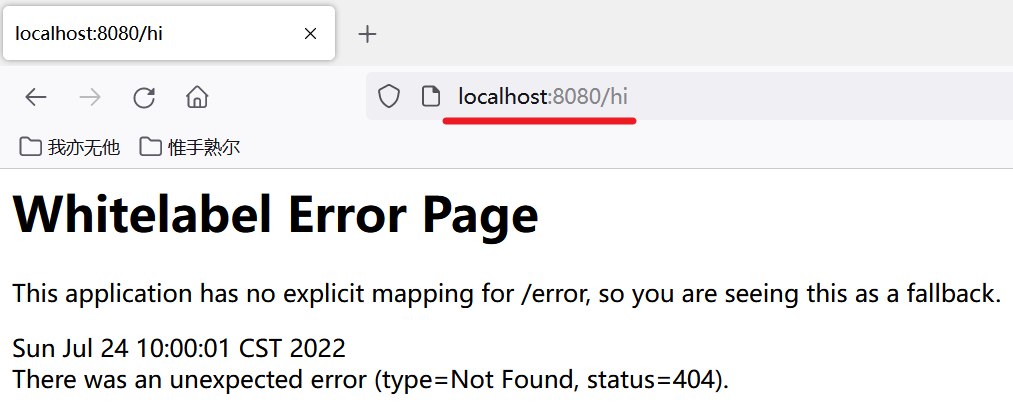
- 修改 MainApp.java,增加扫描的包,并完成测试
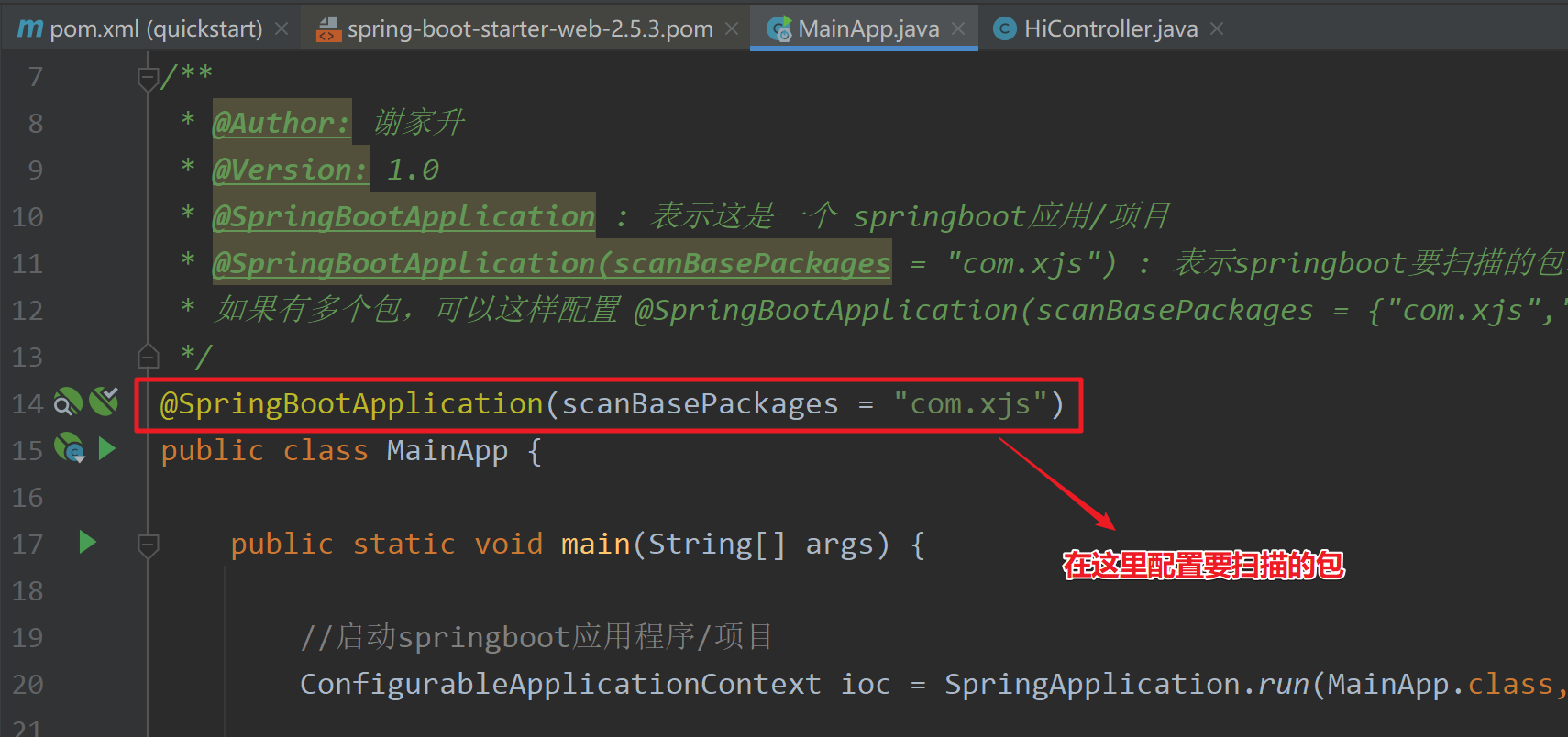
package com.xjs.springboot;
import org.springframework.boot.SpringApplication;
import org.springframework.boot.autoconfigure.SpringBootApplication;
import org.springframework.context.ConfigurableApplicationContext;
/** * @Author: 谢家升 * @Version: 1.0 * @SpringBootApplication : 表示这是一个 springboot应用/项目 * @SpringBootApplication(scanBasePackages = "com.xjs") : 表示springbootPackages and subpackages to scan(Multiple packets can be passed in[数组]) * 如果有多个包,可以这样配置 @SpringBootApplication(scanBasePackages = {"com.xjs","xxx,yyy.zzz"}) */
@SpringBootApplication(scanBasePackages = "com.xjs")
public class MainApp {
public static void main(String[] args) {
//启动springboot应用程序/项目
ConfigurableApplicationContext ioc = SpringApplication.run(MainApp.class, args);
//How to view injected components in container
String[] beanDefinitionNames = ioc.getBeanDefinitionNames();
for (String beanDefinitionName : beanDefinitionNames) {
System.out.println("beanDefinitionName= " + beanDefinitionName);
}
}
}
-----配置完成,重新启动项目,就可以访问HiController-----

2.3.3.2 resources\application.properties 配置大全
- SpringBoot 项目最重要也是最核心的配置文件就是 application.properties,All framework configurations can be specified in this configuration file
- 地址:https://blog.csdn.net/pbrlovejava/article/details/82659702
#SPRING CONFIG(ConfigFileApplicationListener)
spring.config.name =#配置文件名(默认 为 'application' )
spring.config.location =#配置文件的位置
# 多环境配置文件激活属性
spring.profiles.active=dev #加载application-dev.properties配置文件内容
application-dev.properties: #开发环境
application-test.properties: #测试环境
application-prod.properties: #生产环境
#activemq
spring.activemq.broker-url #指定ActiveMQ broker的URL,默认自动生成.
spring.activemq.in-memory #是否是内存模式,默认为true.
spring.activemq.password #指定broker的密码.
spring.activemq.pooled #是否创建PooledConnectionFactory,而非ConnectionFactory,默认false
spring.activemq.user #指定broker的用户.
#aop
spring.aop.auto #是否支持@EnableAspectJAutoProxy,默认为: true
spring.aop.proxy-target-class #true为使用CGLIB代理,false为JDK代理,默认为false
#application
spring.application.admin.enabled #是否启用admin特性,默认为: false
spring.application.admin.jmx-name #指定admin MBean的名称,默认为: org.springframework.boot:type=Admin,name=SpringApplication
#artemis(HornetQ捐献给apache后的版本)
spring.artemis.embedded.cluster-password #指定集群的密码,默认是启动时随机生成.
spring.artemis.embedded.data-directory #指定Journal文件的目录.如果不开始持久化则不必要指定.
spring.artemis.embedded.enabled #是否开启内嵌模式,默认true
spring.artemis.embedded.persistent #是否开启persistent store,默认false.
spring.artemis.embedded.queues #指定启动时创建的队列,多个用逗号分隔,默认: []
spring.artemis.embedded.server-id #指定Server ID. 默认是一个自增的数字,从0开始.
spring.artemis.embedded.topics #指定启动时创建的topic,多个的话逗号分隔,默认: []
spring.artemis.host #指定Artemis broker 的host. 默认: localhost
spring.artemis.mode #指定Artemis 的部署模式, 默认为auto-detected(也可以为native or embedded).
spring.artemis.port #指定Artemis broker 的端口,默认为: 61616
#autoconfig
spring.autoconfigure.exclude #配置要排除的Auto-configuration classes.
#batch
spring.batch.initializer.enabled #是否在必要时创建batch表,默认为true
spring.batch.job.enabled #是否在启动时开启batch job,默认为true
spring.batch.job.names #指定启动时要执行的job的名称,逗号分隔,默认所有job都会被执行
spring.batch.schema #指定要初始化的sql语句路径,默认:classpath:org/springframework/batch/core/[email protected]@[email protected]@.sql)
spring.batch.table-prefix #指定批量处理的表的前缀.
#cookie、session配置
server.session.cookie.comment #指定session cookie的comment
server.session.cookie.domain #指定session cookie的domain
server.session.cookie.http-only #是否开启HttpOnly.
server.session.cookie.max-age #设定session cookie的最大age.
server.session.cookie.name #设定Session cookie 的名称.
server.session.cookie.path #设定session cookie的路径.
server.session.cookie.secure #设定session cookie的“Secure” flag.
server.session.persistent #重启时是否持久化session,默认false
server.session.timeout #session的超时时间
server.session.tracking-modes #设定Session的追踪模式(cookie, url, ssl).
#datasource
spring.dao.exceptiontranslation.enabled #是否开启PersistenceExceptionTranslationPostProcessor,默认为true
spring.datasource.abandon-when-percentage-full #设定超时被废弃的连接占到多少比例时要被关闭或上报
spring.datasource.allow-pool-suspension #使用Hikari pool时,是否允许连接池暂停,默认为: false
spring.datasource.alternate-username-allowed #是否允许替代的用户名.
spring.datasource.auto-commit #指定updates是否自动提交.
spring.datasource.catalog #指定默认的catalog.
spring.datasource.commit-on-return #设置当连接被归还时,是否要提交所有还未完成的事务
spring.datasource.connection-init-sql #指定连接被创建,再被添加到连接池之前执行的sql.
spring.datasource.connection-init-sqls #使用DBCP connection pool时,指定初始化时要执行的sql
spring.datasource.connection-properties.[key] #在使用DBCP connection pool时指定要配置的属性
spring.datasource.connection-test-query #指定校验连接合法性执行的sql语句
spring.datasource.connection-timeout #指定连接的超时时间,毫秒单位.
spring.datasource.continue-on-error #在初始化数据库时,遇到错误是否继续,默认false
spring.datasource.data #指定Data (DML)脚本
spring.datasource.data-source-class-name #指定数据源的全限定名.
spring.datasource.data-source-jndi #指定jndi的地址
spring.datasource.data-source-properties.[key] #使用Hikari connection pool时,指定要设置的属性
spring.datasource.db-properties #使用Tomcat connection pool,指定要设置的属性
spring.datasource.default-auto-commit #是否自动提交.
spring.datasource.default-catalog #指定连接默认的catalog.
spring.datasource.default-read-only #是否设置默认连接只读.
spring.datasource.default-transaction-isolation #指定连接的事务的默认隔离级别.
spring.datasource.driver-class-name #指定driver的类名,默认从jdbc url中自动探测.
spring.datasource.fair-queue #是否采用FIFO返回连接.
spring.datasource.health-check-properties.[key] #使用Hikari connection pool时,在心跳检查时传递的属性
spring.datasource.idle-timeout #指定连接多久没被使用时,被设置为空闲,默认为10ms
spring.datasource.ignore-exception-on-pre-load #当初始化连接池时,是否忽略异常.
spring.datasource.init-sql #当连接创建时,执行的sql
spring.datasource.initial-size #指定启动连接池时,初始建立的连接数量
spring.datasource.initialization-fail-fast #当创建连接池时,没法创建指定最小连接数量是否抛异常
spring.datasource.initialize #指定初始化数据源,是否用data.sql来初始化,默认: true
spring.datasource.isolate-internal-queries #指定内部查询是否要被隔离,默认为false
spring.datasource.jdbc-interceptors #使用Tomcat connection pool时,指定jdbc拦截器,分号分隔
spring.datasource.jdbc-url #指定JDBC URL.
spring.datasource.jmx-enabled #是否开启JMX,默认为: false
spring.datasource.jndi-name #指定jndi的名称.
spring.datasource.leak-detection-threshold #使用Hikari connection pool时,多少毫秒检测一次连接泄露.
spring.datasource.log-abandoned #使用DBCP connection pool,是否追踪废弃statement或连接,默认为: false
spring.datasource.log-validation-errors #当使用Tomcat connection pool是否打印校验错误.
spring.datasource.login-timeout #指定连接数据库的超时时间.
spring.datasource.max-active #指定连接池中最大的活跃连接数.
spring.datasource.max-age #指定连接池中连接的最大年龄
spring.datasource.max-idle #指定连接池最大的空闲连接数量.
spring.datasource.max-lifetime #指定连接池中连接的最大生存时间,毫秒单位.
spring.datasource.max-open-prepared-statements #指定最大的打开的prepared statements数量.
spring.datasource.max-wait #指定连接池等待连接返回的最大等待时间,毫秒单位.
spring.datasource.maximum-pool-size #指定连接池最大的连接数,包括使用中的和空闲的连接.
spring.datasource.min-evictable-idle-time-millis #指定一个空闲连接最少空闲多久后可被清除.
spring.datasource.min-idle #指定必须保持连接的最小值(For DBCP and Tomcat connection pools)
spring.datasource.minimum-idle #指定连接维护的最小空闲连接数,当使用HikariCP时指定.
spring.datasource.name #指定数据源名.
spring.datasource.num-tests-per-eviction-run #指定运行每个idle object evictor线程时的对象数量
spring.datasource.password #指定数据库密码.
spring.datasource.platform #指定schema要使用的Platform(schema-${platform}.sql),默认为: all
spring.datasource.pool-name #指定连接池名字.
spring.datasource.pool-prepared-statements #指定是否池化statements.
spring.datasource.propagate-interrupt-state #在等待连接时,如果线程被中断,是否传播中断状态.
spring.datasource.read-only #当使用Hikari connection pool时,是否标记数据源只读
spring.datasource.register-mbeans #指定Hikari connection pool是否注册JMX MBeans.
spring.datasource.remove-abandoned #指定当连接超过废弃超时时间时,是否立刻删除该连接.
spring.datasource.remove-abandoned-timeout #指定连接应该被废弃的时间.
spring.datasource.rollback-on-return #在归还连接时,是否回滚等待中的事务.
spring.datasource.schema #指定Schema (DDL)脚本.
spring.datasource.separator #指定初始化脚本的语句分隔符,默认: ;
spring.datasource.sql-script-encoding #指定SQL scripts编码.
spring.datasource.suspect-timeout #指定打印废弃连接前的超时时间.
spring.datasource.test-on-borrow #当从连接池借用连接时,是否测试该连接.
spring.datasource.test-on-connect #创建时,是否测试连接
spring.datasource.test-on-return #在连接归还到连接池时是否测试该连接.
spring.datasource.test-while-idle #当连接空闲时,是否执行连接测试.
spring.datasource.time-between-eviction-runs-millis #指定空闲连接检查、废弃连接清理、空闲连接池大小调整之间的操作时间间隔
spring.datasource.transaction-isolation #指定事务隔离级别,使用Hikari connection pool时指定
spring.datasource.url #指定JDBC URL.
spring.datasource.use-disposable-connection-facade #是否对连接进行包装,防止连接关闭之后被使用.
spring.datasource.use-equals #比较方法名时是否使用String.equals()替换==.
spring.datasource.use-lock #是否对连接操作加锁
spring.datasource.username #指定数据库名.
spring.datasource.validation-interval #指定多少ms执行一次连接校验.
spring.datasource.validation-query #指定获取连接时连接校验的sql查询语句.
spring.datasource.validation-query-timeout #指定连接校验查询的超时时间.
spring.datasource.validation-timeout #设定连接校验的超时时间,当使用Hikari connection pool时指定
spring.datasource.validator-class-name #用来测试查询的validator全限定名.
spring.datasource.xa.data-source-class-name #指定数据源的全限定名.
spring.datasource.xa.properties #指定传递给XA data source的属性
#data springdata
spring.data.elasticsearch.cluster-name #指定es集群名称,默认: elasticsearch
spring.data.elasticsearch.cluster-nodes #指定es的集群,逗号分隔,不指定的话,则启动client node.
spring.data.elasticsearch.properties #指定要配置的es属性.
spring.data.elasticsearch.repositories.enabled #是否开启es存储,默认为: true
spring.data.jpa.repositories.enabled #是否开启JPA支持,默认为: true
spring.data.mongodb.authentication-database #指定鉴权的数据库名
spring.data.mongodb.database #指定mongodb数据库名
spring.data.mongodb.field-naming-strategy #指定要使用的FieldNamingStrategy.
spring.data.mongodb.grid-fs-database #指定GridFS database的名称.
spring.data.mongodb.host #指定Mongo server host.
spring.data.mongodb.password #指定Mongo server的密码.
spring.data.mongodb.port #指定Mongo server port.
spring.data.mongodb.repositories.enabled #是否开启mongodb存储,默认为true
spring.data.mongodb.uri #指定Mongo database URI.默认:mongodb://localhost/test
spring.data.mongodb.username #指定登陆mongodb的用户名.
spring.data.rest.base-path #指定暴露资源的基准路径.
spring.data.rest.default-page-size #指定每页的大小,默认为: 20
spring.data.rest.limit-param-name #指定limit的参数名,默认为: size
spring.data.rest.max-page-size #指定最大的页数,默认为1000
spring.data.rest.page-param-name #指定分页的参数名,默认为: page
spring.data.rest.return-body-on-create #当创建完实体之后,是否返回body,默认为false
spring.data.rest.return-body-on-update #在更新完实体后,是否返回body,默认为false
spring.data.rest.sort-param-name #指定排序使用的key,默认为: sort
spring.data.solr.host #指定Solr host,如果有指定了zk的host的话,则忽略.默认为: http://127.0.0.1:8983/solr
spring.data.solr.repositories.enabled #是否开启Solr repositories,默认为: true
spring.data.solr.zk-host #指定zk的地址,格式为HOST:PORT.
#----------------------------------------
#DEVTOOLS属性
#----------------------------------------
#DEVTOOLS(DevToolsProperties)
spring.devtools.livereload.enabled = true #启用livereload.com兼容的server.
spring.devtools.livereload.port = 35729 #服务器端口.
spring.devtools.restart.additional-exclude = #Additional modes that should be excluded from triggering a full restart.
spring.devtools.restart.additional-paths = #Additional paths to observe changes.
spring.devtools.restart.enabled = true #启用自动重启.
spring.devtools.restart.exclude = META-INF /行家/ **,META-INF /资源/ **,资源/ **,静态/ **,公共/ **,模板/ **,** / * Test.class,** / * Tests.class,git.properties#Modes that trigger a full reboot should be excluded.
spring.devtools.restart.poll-interval = 1000 #polling The time to wait between path changes(以毫秒为单位).
spring.devtools.restart.quiet-period = 400 #触发重新启动之前,There is no silent time required for any classpath changes(以毫秒为单位).
spring.devtools.restart.trigger-file = #特定文件的名称,A restart check is triggered on change.如果未指定任何类路径文件更改将触发重新启动.
#DEVTOOLS REMOTE DEVTOOLS(RemoteDevToolsProperties)
spring.devtools.remote.context-path = #用于处理远程连接的上下文路径.
spring.devtools.remote.debug.enabled = true #启用远程调试支持.
spring.devtools.remote.debug.local-port = 8000 #本地远程调试服务器端口.
spring.devtools.remote.proxy.host = #用于连接远程应用程序的代理主机.
spring.devtools.remote.proxy.port = #用于连接远程应用程序的代理端口.
spring.devtools.remote.restart.enabled = true #启用远程重启.
spring.devtools.remote.secret = #建立连接所需的共享密钥(需要启用远程支持).
spring.devtools.remote.secret-header-name = X-AUTH-TOKEN #用于传输共享密钥的HTTP头.
#----------------------------------------
#执行器属性
#----------------------------------------
#ENDPOINTS(AbstractEndpoint子类)
endpoints.enabled = true #启用端点.
endpoints.sensitive = #Default endpoint sensitive settings.
endpoints.actuator.enabled = true #启用端点.
endpoints.actuator.path = #端点URL路径.
endpoints.actuator.sensitive = false #在端点上启用安全性.
endpoints.autoconfig.enabled = #启用端点.
endpoints.autoconfig.id = #端点标识符.
endpoints.autoconfig.sensitive = #标记端点是否暴露敏感信息.
endpoints.beans.enabled = #启用端点.
endpoints.beans.id = #端点标识符.
endpoints.beans.sensitive = #标记端点是否暴露敏感信息.
endpoints.configprops.enabled = #启用端点.
endpoints.configprops.id = #端点标识符.
endpoints.configprops.keys-to-sanitize #应该清理的密钥.A key can be a simple string with an attribute ending with or a regular expression.
endpoints.configprops.sensitive = #Marks whether the endpoint exposes sensitive information.
endpoints.docs.curies.enabled = false #Enable Curie generation.
endpoints.docs.enabled = true #Enable the actuator document endpoint.
endpoints.docs.path = / docs #
endpoints.docs.sensitive = false #
#终端CORS配置(EndpointCorsProperties)
endpoints.cors.allow-credentials = #设置是否支持凭据.未设置时,Credentials are not supported.
endpoints.cors.allowed-headers = #A comma-separated list of headers is allowed in the request.'*'允许所有标题.
endpoints.cors.allowed-methods = GET #逗号分隔的允许的方法列表.'*'允许所有的方法.
endpoints.cors.allowed-origins = #A comma-separated list of origins is allowed.'*'All sources are allowed.未设置时,CORSSupport is disabled.
endpoints.cors.exposed-headers = #A comma-separated list of headers to include in the response.
endpoints.cors.max-age = 1800 #以秒为单位,Clients can cache responses to pre-flight requests.
#JMX ENDPOINT(EndpointMBeanExportProperties)
endpoints.jmx.domain = #JMX域名.如果设置,则用“spring.jmx.default-domain”的值初始化.
endpoints.jmx.enabled = true #启用所有端点的JMX导出.
endpoints.jmx.static-names = #Appends to all that represent endpointsMBean的ObjectName的静态属性.
endpoints.jmx.unique-names = false #确保ObjectNamesModified in case of conflict.
#flyway
flyway.baseline-description #对执行迁移时基准版本的描述.
flyway.baseline-on-migrate #当迁移时发现目标schema非空,而且带有没有元数据的表时,是否自动执行基准迁移,默认false.
flyway.baseline-version #开始执行基准迁移时对现有的schema的版本打标签,默认值为1.
flyway.check-location #检查迁移脚本的位置是否存在,默认false.
flyway.clean-on-validation-error #当发现校验错误时是否自动调用clean,默认false.
flyway.enabled #是否开启flywary,默认true.
flyway.encoding #设置迁移时的编码,默认UTF-8.
flyway.ignore-failed-future-migration #当读取元数据表时是否忽略错误的迁移,默认false.
flyway.init-sqls #当初始化好连接时要执行的SQL.
flyway.locations #迁移脚本的位置,默认db/migration.
flyway.out-of-order #是否允许无序的迁移,默认false.
flyway.password #目标数据库的密码.
flyway.placeholder-prefix #设置每个placeholder的前缀,默认${.
flyway.placeholder-replacement #placeholders是否要被替换,默认true.
flyway.placeholder-suffix #设置每个placeholder的后缀,默认}.
flyway.placeholders.[placeholder name] #设置placeholder的value
flyway.schemas #设定需要flywary迁移的schema,大小写敏感,默认为连接默认的schema.
flyway.sql-migration-prefix #迁移文件的前缀,默认为V.
flyway.sql-migration-separator #迁移脚本的文件名分隔符,默认__
flyway.sql-migration-suffix #迁移脚本的后缀,默认为.sql
flyway.table #flyway使用的元数据表名,默认为schema_version
flyway.target #迁移时使用的目标版本,默认为latest version
flyway.url #迁移时使用的JDBC URL,如果没有指定的话,将使用配置的主数据源
flyway.user #迁移数据库的用户名
flyway.validate-on-migrate #迁移时是否校验,默认为true.
#FREEMARKER(FreeMarkerAutoConfiguration)
spring.freemarker.allowRequestOverride = false #设置HttpServletRequestWhether the property is allowed to be overridden(隐藏)控制器生成的相同名称的模型属性.
spring.freemarker.allowSessionOverride = false #设置HttpSessionWhether the property is allowed to be overridden(隐藏)控制器生成的相同名称的模型属性.
spring.freemarker.cache = true #使用模板缓存.
spring.freemarker.charset=UTF-8 # Template encoding.
spring.freemarker.checkTemplateLocation = true #检查模板位置是否存在spring.freemarker.check-template-location=true
spring.freemarker.contentType = text / html #Content-Type
spring.freemarker.exposeRequestAttributes = false #在与模板合并之前,Sets whether all request attributes should be added to the model.spring.freemarker.expose-request-attributes=false
spring.freemarker.exposeSessionAttributes = false #在与模板合并之前,Set whether all should be setHttpSession属性添加到模型中.spring.freemarker.expose-session-attributes=false
spring.freemarker.exposeSpringMacroHelpers = false #设定是否以springMacroRequestContext的形式暴露RequestContext给Spring’s macro library使用 spring.freemarker.expose-spring-macro-helpers=true
spring.freemarker.prefer-file-system-access=true #是否优先从文件系统加载template,以支持热加载,默认为true
spring.freemarker.prefix = #在构建URL时,The prefix is pre-specified to see the name.
spring.freemarker.requestContextAttribute = #所有视图的RequestContext属性的名称. freemarker.request-context-attribute=
spring.freemarker.settings.* = #Well-known FreeMarker keys which will be passed to FreeMarker's Configuration
spring.freemarker.suffix = .ftl #在构建URLsuffix appended to the view name
spring.freemarker.templateEncoding = UTF- 8
spring.freemarker.templateLoaderPath =classpath:/templates #设定ftl文件路径 类路径:/模板/
spring.freemarker.viewNames = #可以解析的视图名称的白名单
spring.mvc.static-path-pattern=/static/** #设定静态文件路径,js,css等
#GIT信息
spring.git.properties = #生成的git信息属性文件的资源引用.
#GROOVY模板(GroovyTemplateAutoConfiguration)
spring.groovy.template.allow-request-override #指定HttpServletRequest的属性是否可以覆盖controller的model的同名项
spring.groovy.template.allow-session-override #指定HttpSession的属性是否可以覆盖controller的model的同名项
spring.groovy.template.cache #是否开启模板缓存
.spring.groovy.template.charset #指定Template编码
.spring.groovy.template.check-template-location #是否检查模板的路径是否存在.
spring.groovy.template.configuration.auto-escape #是否在渲染模板时自动排查model的变量,默认为: false
spring.groovy.template.configuration.auto-indent #是否在渲染模板时自动缩进,默认为false
spring.groovy.template.configuration.auto-indent-string #如果自动缩进启用的话,是使用SPACES还是TAB,默认为: SPACES
spring.groovy.template.configuration.auto-new-line #渲染模板时是否要输出换行,默认为false
spring.groovy.template.configuration.base-template-class #指定template base class.
spring.groovy.template.configuration.cache-templates #是否要缓存模板,默认为true
spring.groovy.template.configuration.declaration-encoding #在写入declaration header时使用的编码
spring.groovy.template.configuration.expand-empty-elements #是使用<br/>这种形式,还是<br></br>这种展开模式,默认为: false)
spring.groovy.template.configuration.locale #指定template locale.
spring.groovy.template.configuration.new-line-string #当启用自动换行时,换行的输出,默认为系统的line.separator属性的值
spring.groovy.template.configuration.resource-loader-path #指定groovy的模板路径,默认为classpath:/templates/
spring.groovy.template.configuration.use-double-quotes #指定属性要使用双引号还是单引号,默认为false
spring.groovy.template.content-type #指定Content-Type.
spring.groovy.template.enabled #是否开启groovy模板的支持.
spring.groovy.template.expose-request-attributes #设定所有request的属性在merge到模板的时候,是否要都添加到model中.
spring.groovy.template.expose-session-attributes #设定所有request的属性在merge到模板的时候,是否要都添加到model中.
spring.groovy.template.expose-spring-macro-helpers #设定是否以springMacroRequestContext的形式暴露RequestContext给Spring’s macro library使用
spring.groovy.template.prefix #指定模板的前缀.
spring.groovy.template.request-context-attribute #指定RequestContext属性的名.
spring.groovy.template.resource-loader-path #指定模板的路径,默认为: classpath:/templates/
spring.groovy.template.suffix #指定模板的后缀
spring.groovy.template.view-names #指定要使用模板的视图名称.
#h2
spring.h2.console.enabled #是否开启控制台,默认为false
spring.h2.console.path #指定控制台路径,默认为: /h2-console
#hornetq (HornetQProperties)
spring.hornetq.embedded.cluster-password #指定集群的密码,默认启动时随机生成.
spring.hornetq.embedded.data-directory #指定Journal file 的目录. 如果不开启持久化则不必指定.
spring.hornetq.embedded.enabled #是否开启内嵌模式,默认:true
spring.hornetq.embedded.persistent #是否开启persistent store,默认: false
spring.hornetq.embedded.queues #指定启动是创建的queue,多个以逗号分隔,默认: []
spring.hornetq.embedded.server-id #指定Server ID. 默认使用自增数字,从0开始.
spring.hornetq.embedded.topics #指定启动时创建的topic,多个以逗号分隔,默认: []
spring.hornetq.host #指定HornetQ broker 的host,默认: localhost
spring.hornetq.mode #指定HornetQ 的部署模式,默认是auto-detected,也可以指定native 或者 embedded.
spring.hornetq.port #指定HornetQ broker 端口,默认: 5445
#http
spring.hateoas.apply-to-primary-object-mapper #设定是否对object mapper也支持HATEOAS,默认为: true
spring.http.converters.preferred-json-mapper #是否优先使用JSON mapper来转换.
spring.http.encoding.charset #指定http请求和相应的Charset,默认: UTF-8
spring.http.encoding.enabled #是否开启http的编码支持,默认为true
spring.http.encoding.force #是否强制对http请求和响应进行编码,默认为true
#jersey
spring.jersey.filter.order #指定Jersey filter的order,默认为: 0
spring.jersey.init #指定传递给Jersey的初始化参数.
spring.jersey.type #指定Jersey的集成类型,可以是servlet或者filter.
#jms
spring.jms.jndi-name #指定Connection factory JNDI 名称.
spring.jms.listener.acknowledge-mode #指定ack模式,默认自动ack.
spring.jms.listener.auto-startup #是否启动时自动启动jms,默认为: true
spring.jms.listener.concurrency #指定最小的并发消费者数量.
spring.jms.listener.max-concurrency #指定最大的并发消费者数量.
spring.jms.pub-sub-domain #是否使用默认的destination type来支持 publish/subscribe,默认: false
jmx
spring.jmx.default-domain #指定JMX domain name.
spring.jmx.enabled #是否暴露jmx,默认为true
spring.jmx.server #指定MBeanServer bean name. 默认为: mbeanServer)
#jooq
spring.jooq.sql-dialect #指定JOOQ使用的SQLDialect,比如POSTGRES.
#Messages
spring.messages.basename #指定message的basename,多个以逗号分隔,如果不加包名的话,默认从classpath路径开始,默认: messages
spring.messages.cache-seconds #设定加载的资源文件缓存失效时间,-1的话为永不过期,默认为-1
spring.messages.encoding #设定Message bundles的编码,默认: UTF-8
#JPA
spring.jpa.database #指定目标数据库.
spring.jpa.database-platform #指定目标数据库的类型.
spring.jpa.generate-ddl #是否在启动时初始化schema,默认为false
spring.jpa.hibernate.ddl-auto #指定DDL mode (none, validate, update, create, create-drop). 当使用内嵌数据库时,默认是create-drop,否则为none.
spring.jpa.hibernate.naming-strategy #指定命名策略.
spring.jpa.open-in-view #是否注册OpenEntityManagerInViewInterceptor,绑定JPA EntityManager到请求线程中,默认为: true
spring.jpa.properties #添加额外的属性到JPA provider.
spring.jpa.show-sql #是否开启sql的log,默认为: false
#json
spring.jackson.date-format #指定日期格式,比如yyyy-MM-dd HH:mm:ss,或者具体的格式化类的全限定名
spring.jackson.deserialization #是否开启Jackson的反序列化
spring.jackson.generator #是否开启json的generators.
spring.jackson.joda-date-time-format #指定Joda date/time的格式,比如yyyy-MM-dd HH:mm:ss). 如果没有配置的话,dateformat会作为backup
spring.jackson.locale #指定json使用的Locale.
spring.jackson.mapper #是否开启Jackson通用的特性.
spring.jackson.parser #是否开启jackson的parser特性.
spring.jackson.property-naming-strategy #指定PropertyNamingStrategy (CAMEL_CASE_TO_LOWER_CASE_WITH_UNDERSCORES)或者指定PropertyNamingStrategy子类的全限定类名.
spring.jackson.serialization #是否开启jackson的序列化.
spring.jackson.serialization-inclusion #指定序列化时属性的inclusion方式,具体查看JsonInclude.Include枚举.
spring.jackson.time-zone #指定日期格式化时区,比如America/Los_Angeles或者GMT+10.
#JTA
spring.jta.allow-multiple-lrc #是否允许 multiple LRC,默认为: false
spring.jta.asynchronous2-pc #指定两阶段提交是否可以异步,默认为: false
spring.jta.background-recovery-interval #指定多少分钟跑一次recovery process,默认为: 1
spring.jta.background-recovery-interval-seconds #指定多久跑一次recovery process,默认: 60
spring.jta.current-node-only-recovery #是否过滤掉其他非本JVM的recovery,默认为: true
spring.jta.debug-zero-resource-transaction #是否追踪没有使用指定资源的事务,默认为: false
spring.jta.default-transaction-timeout #设定默认的事务超时时间,默认为60
spring.jta.disable-jmx #是否禁用jmx,默认为false
spring.jta.enabled #是否开启JTA support,默认为: true
spring.jta.exception-analyzer #设置指定的异常分析类
spring.jta.filter-log-status #使用Bitronix Transaction Manager时,是否写mandatory logs,开启的话,可以节省磁盘空间,但是调试会复杂写,默认为false
spring.jta.force-batching-enabled #使用Bitronix Transaction Manager时,是否批量写磁盘,默认为true.
spring.jta.forced-write-enabled #使用Bitronix Transaction Manager时,是否强制写日志到磁盘,默认为true
spring.jta.graceful-shutdown-interval #当使用Bitronix Transaction Manager,指定shutdown时等待事务结束的时间,超过则中断,默认为60
spring.jta.jndi-transaction-synchronization-registry-name #当使用Bitronix Transaction Manager时,在JNDI下得事务同步registry,默认为: java:comp/TransactionSynchronizationRegistry
spring.jta.jndi-user-transaction-name #指定在JNDI使用Bitronix Transaction Manager的名称,默认:java:comp/UserTransaction
spring.jta.journal #当使用Bitronix Transaction Manager,指定The journal是否disk还是null还是一个类的全限定名,默认disk
spring.jta.log-dir #Transaction logs directory.
spring.jta.log-part1-filename #指定The journal fragment文件1的名字,默认: btm1.tlog
spring.jta.log-part2-filename #指定The journal fragment文件2的名字,默认: btm2.tlog
spring.jta.max-log-size-in-mb #指定journal fragments大小的最大值. 默认: 2M
spring.jta.resource-configuration-filename #指定Bitronix Transaction Manager配置文件名.
spring.jta.server-id #指定Bitronix Transaction Manager实例的id.
spring.jta.skip-corrupted-logs #是否忽略corrupted log files文件,默认为false.
spring.jta.transaction-manager-id #指定Transaction manager的唯一标识.
spring.jta.warn-about-zero-resource-transaction #当使用Bitronix Transaction Manager时,是否对没有使用指定资源的事务进行警告,默认为: true
#mail
spring.mail.default-encoding #指定默认MimeMessage的编码,默认为: UTF-8
spring.mail.host #指定SMTP server host.
spring.mail.jndi-name #指定mail的jndi名称
spring.mail.password #指定SMTP server登陆密码.
spring.mail.port #指定SMTP server port.
spring.mail.properties #指定JavaMail session属性.
spring.mail.protocol #指定SMTP server使用的协议,默认为: smtp
spring.mail.test-connection #指定是否在启动时测试邮件服务器连接,默认为false
spring.mail.username #指定SMTP server的用户名.
#mobile
spring.mobile.devicedelegatingviewresolver.enable-fallback #是否支持fallback的解决方案,默认false
spring.mobile.devicedelegatingviewresolver.enabled #是否开始device view resolver,默认为: false
spring.mobile.devicedelegatingviewresolver.mobile-prefix #设定mobile端视图的前缀,默认为:mobile/
spring.mobile.devicedelegatingviewresolver.mobile-suffix #设定mobile视图的后缀
spring.mobile.devicedelegatingviewresolver.normal-prefix #设定普通设备的视图前缀
spring.mobile.devicedelegatingviewresolver.normal-suffix #设定普通设备视图的后缀
spring.mobile.devicedelegatingviewresolver.tablet-prefix #设定平板设备视图前缀,默认:tablet/
spring.mobile.devicedelegatingviewresolver.tablet-suffix #设定平板设备视图后缀.
spring.mobile.sitepreference.enabled #是否启用SitePreferenceHandler,默认为: true
#MONGODB(Mongo性能)
spring.data.mongodb.host = #db host
spring.data.mongodb.port = 27017 #连接端口(默认为 27107 )
spring.data.mongodb.uri = #连接URL
spring.mongodb.embedded.features #指定要开启的特性,逗号分隔.
spring.mongodb.embedded.version #指定要使用的版本,默认: 2.6.10
#MANAGEMENT HTTP SERVER(ManagementServerProperties)
management.add-application-context-header = true#在每个响应中添加“X-Application-Context”HTTP标头.
management.address = #The network address to which the management endpoint should bind.
management.context-path = #管理端点上下文路径.例如`/执行器`
management.port = #管理端点HTTP端口.默认使用与应用程序相同的端口.
management.security.enabled = true #启用
management.security.role = ADMIN #访问管理端点所需的角色.
management.security.sessions #会话创建策略使用(always, never, if_required, stateless).
#HEALTH INDICATORS健康指标(previous health conditions*)
management.health.db.enabled = true #启用数据库运行状况检查.
management.health.defaults.enabled = true #Enable default health metrics.
management.health.diskspace.enabled = true #启用磁盘空间运行状况检查.
management.health.diskspace.path = #用于计算可用磁盘空间的路径.
management.health.diskspace.threshold = 0 #应该可用的最小磁盘空间(以字节为单位).
management.health.elasticsearch.enabled = true #启用elasticsearch运行状况检查.
management.health.elasticsearch.indices = #逗号分隔的索引名称.
management.health.elasticsearch.response-timeout = 100 #等待群集响应的时间(以毫秒为单位).
management.health.jms.enabled = true #启用JMS运行状况检查.
management.health.mail.enabled = true #启用邮件运行状况检查.
management.health.mongo.enabled = true #启用MongoDB运行状况检查.
management.health.rabbit.enabled = true #启用RabbitMQ健康检查.
management.health.redis.enabled = true #启用Redis运行状况检查.
management.health.solr.enabled = true #启用Solr运行状况检查.
management.health.status.order #以逗号分隔的健康状态列表.
management.trace.include #要包含在跟踪中的项目.
#METRICS EXPORT(MetricExportProperties)
spring.metrics.export.aggregate.key-pattern = #A pattern that tells the aggregator what to do with keys in the source repository.
spring.metrics.export.aggregate.prefix = #Prefix for the global repository(如果处于活动状态).
spring.metrics.export.delay-millis = 5000 #Delay between output ticks(以毫秒为单位).Metrics are exported to external sources as scheduled.
spring.metrics.export.enabled = true #启用metric Flags for standard exports(假设MetricWriter可用).
spring.metrics.export.excludes = #要排除的metric A list of patterns for standard names.Include post application.
spring.metrics.export.includes = #要包含的metric A list of patterns for standard names.
spring.metrics.export.redis.key #RedisRepository export key(如果有效).
spring.metrics.export.redis.prefix #如果处于活动状态,redis存储库的前缀.
spring.metrics.export.send-latest #According to not exporting unchangedmetric The value of the flag turns off all available optimizations.
spring.metrics.export.statsd.host = #Receive exportmetric 的statsd server的主机.
spring.metrics.export.statsd.port = 8125 #Receive exportmetric的statsd server的端口.
spring.metrics.export.statsd.prefix = #统计导出metric的前缀.
spring.metrics.export.triggers.* = #每个MetricWriter bean名称的特定触发器属性.
#multipart
multipart.enabled #是否开启文件上传支持,默认为true
multipart.file-size-threshold #设定文件写入磁盘的阈值,单位为MB或KB,默认为0
multipart.location #指定文件上传路径.
multipart.max-file-size #指定文件大小最大值,默认1MB
multipart.max-request-size #指定每次请求的最大值,默认为10MB
#mustcache
spring.mustache.cache #是否Enable template caching.
spring.mustache.charset #指定Template的编码.
spring.mustache.check-template-location #是否检查默认的路径是否存在.
spring.mustache.content-type #指定Content-Type.
spring.mustache.enabled #是否开启mustcache的模板支持.
spring.mustache.prefix #指定模板的前缀,默认: classpath:/templates/
spring.mustache.suffix #指定模板的后缀,默认: .html
spring.mustache.view-names #指定要使用模板的视图名.
#MVC(SPRING MVC相关的一些配置)
http.mappers.json-pretty-print = false #打印JSON
http.mappers.json-sort-keys = false #排序键
spring.mvc.locale = #Set a fixed locale,例如en_UK
spring.mvc.date-format = #设置固定的日期格式,例如dd / MM / yyyy
spring.mvc.async.request-timeout #设定async请求的超时时间,以毫秒为单位,如果没有设置的话,以具体实现的超时时间为准,比如tomcat的servlet3的话是10秒.
spring.mvc.favicon.enabled #是否支持favicon.ico,默认为: true
spring.mvc.ignore-default-model-on-redirect #在重定向时是否忽略默认model的内容,默认为true
spring.mvc.locale#指定使用的Locale.
spring.mvc.message-codes-resolver-format #指定message codes的格式化策略(PREFIX_ERROR_CODE,POSTFIX_ERROR_CODE).
spring.view.prefix = #MVC视图前缀
spring.view.suffix = #...和后缀
spring.resources.cache-period = #Header cache timed out sent to browser
spring.resources.add-mappings = true #如果 Default mappings should be added
#liquibase
liquibase.change-log #Change log 配置文件的路径,默认值为classpath:/db/changelog/db.changelog-master.yaml
liquibase.check-change-log-location #是否坚持change log的位置是否存在,默认为true.
liquibase.contexts #逗号分隔的运行时context列表.
liquibase.default-schema #默认的schema.
liquibase.drop-first #是否首先drop schema,默认为false
liquibase.enabled #是否开启liquibase,默认为true.
liquibase.password #目标数据库密码
liquibase.url #要迁移的JDBC URL,如果没有指定的话,将使用配置的主数据源.
liquibase.user #目标数据用户名
#logging日志
logging.path = #文件路径
logging.file = myapp.log #文件名称
logging.config = #如果你即想完全掌控日志配置,但又不想用logback.xml作为Logback配置的名字,可以通过logging.config属性指定自定义的名字
logging.level.root=INFO #日志级别 从控制台打印出来的日志级别只有ERROR, WARN 还有INFO,如果你想要打印debug级别的日志,可以配置debug=true
logging.level.org.springframework.web=DEBUG
logging.level.org.hibernate=ERROR
#rabbitmq
spring.rabbitmq.addresses #指定client连接到的server的地址,多个以逗号分隔.
spring.rabbitmq.dynamic #是否创建AmqpAdmin bean. 默认为: true)
spring.rabbitmq.host #指定RabbitMQ host.默认为: localhost)
spring.rabbitmq.listener.acknowledge-mode #指定Acknowledge的模式.
spring.rabbitmq.listener.auto-startup #是否在启动时就启动mq,默认: true)
spring.rabbitmq.listener.concurrency #指定最小的消费者数量.
spring.rabbitmq.listener.max-concurrency #指定最大的消费者数量.
spring.rabbitmq.listener.prefetch #指定一个请求能处理多少个消息,如果有事务的话,必须大于等于transaction数量.
spring.rabbitmq.listener.transaction-size #指定一个事务处理的消息数量,最好是小于等于prefetch的数量.
spring.rabbitmq.password #指定broker的密码.
spring.rabbitmq.port #指定RabbitMQ 的端口,默认: 5672)
spring.rabbitmq.requested-heartbeat #指定心跳超时,0为不指定.
spring.rabbitmq.ssl.enabled #是否开始SSL,默认: false)
spring.rabbitmq.ssl.key-store #指定持有SSL certificate的key store的路径
spring.rabbitmq.ssl.key-store-password #指定访问key store的密码.
spring.rabbitmq.ssl.trust-store #指定持有SSL certificates的Trust store.
spring.rabbitmq.ssl.trust-store-password #指定访问trust store的密码.
spring.rabbitmq.username #指定登陆broker的用户名.
spring.rabbitmq.virtual-host #指定连接到broker的Virtual host.
#redis
spring.redis.database #指定连接工厂使用的Database index,默认为: 0
spring.redis.host #指定Redis server host,默认为: localhost
spring.redis.password #指定Redis server的密码
spring.redis.pool.max-active #指定连接池最大的活跃连接数,-1表示无限,默认为8
spring.redis.pool.max-idle #指定连接池最大的空闲连接数,-1表示无限,默认为8
spring.redis.pool.max-wait #指定当连接池耗尽时,新获取连接需要等待的最大时间,以毫秒单位,-1表示无限等待
spring.redis.pool.min-idle #指定连接池中空闲连接的最小数量,默认为0
spring.redis.port #指定redis服务端端口,默认: 6379
spring.redis.sentinel.master #指定redis server的名称
spring.redis.sentinel.nodes #指定sentinel节点,逗号分隔,格式为host:port.
spring.redis.timeout #指定连接超时时间,毫秒单位,默认为0
#resource
spring.resources.add-mappings #是否开启默认的资源处理,默认为true
spring.resources.cache-period #设定资源的缓存时效,以秒为单位.
spring.resources.chain.cache #是否开启缓存,默认为: true
spring.resources.chain.enabled #是否开启资源 handling chain,默认为false
spring.resources.chain.html-application-cache #是否开启h5应用的cache manifest重写,默认为: false
spring.resources.chain.strategy.content.enabled #是否开启内容版本策略,默认为false
spring.resources.chain.strategy.content.paths #指定要应用的版本的路径,多个以逗号分隔,默认为:[/**]
spring.resources.chain.strategy.fixed.enabled #是否开启固定的版本策略,默认为false
spring.resources.chain.strategy.fixed.paths #指定要应用版本策略的路径,多个以逗号分隔
spring.resources.chain.strategy.fixed.version #指定版本策略使用的版本号
spring.resources.static-locations #指定静态资源路径,默认为classpath:[/META-INF/resources/,/resources/, /static/, /public/]以及context:/
#security spring security是springboot支持的权限控制系统.
security.basic.authorize-mode #要使用权限控制模式.
security.basic.enabled #是否开启基本的鉴权,默认为true
security.basic.path #需要鉴权的path,多个的话以逗号分隔,默认为[/**]
security.basic.realm #HTTP basic realm 的名字,默认为Spring
security.enable-csrf #是否开启cross-site request forgery校验,默认为false.
security.filter-order #Security filter chain的order,默认为0
security.headers.cache #是否开启http头部的cache控制,默认为false.
security.headers.content-type #是否开启X-Content-Type-Options头部,默认为false.
security.headers.frame #是否开启X-Frame-Options头部,默认为false.
security.headers.hsts #指定HTTP Strict Transport Security (HSTS)模式(none, domain, all).
security.headers.xss #是否开启cross-site scripting (XSS) 保护,默认为false.
security.ignored #指定不鉴权的路径,多个的话以逗号分隔.
security.oauth2.client.access-token-uri #指定获取access token的URI.
security.oauth2.client.access-token-validity-seconds #指定access token失效时长.
security.oauth2.client.additional-information.[key] #设定要添加的额外信息.
security.oauth2.client.authentication-scheme #指定传输不记名令牌(bearer token)的方式(form, header, none,query),默认为header
security.oauth2.client.authorities #指定授予客户端的权限.
security.oauth2.client.authorized-grant-types #指定客户端允许的grant types.
security.oauth2.client.auto-approve-scopes #对客户端自动授权的scope.
security.oauth2.client.client-authentication-scheme #传输authentication credentials的方式(form, header, none, query),默认为header方式
security.oauth2.client.client-id #指定OAuth2 client ID.
security.oauth2.client.client-secret #指定OAuth2 client secret. 默认是一个随机的secret.
security.oauth2.client.grant-type #指定获取资源的access token的授权类型.
security.oauth2.client.id #指定应用的client ID.
security.oauth2.client.pre-established-redirect-uri #服务端pre-established的跳转URI.
security.oauth2.client.refresh-token-validity-seconds #指定refresh token的有效期.
security.oauth2.client.registered-redirect-uri #指定客户端跳转URI,多个以逗号分隔.
security.oauth2.client.resource-ids #指定客户端相关的资源id,多个以逗号分隔.
security.oauth2.client.scope #client的scope
security.oauth2.client.token-name #指定token的名称
security.oauth2.client.use-current-uri #是否优先使用请求中URI,再使用pre-established的跳转URI. 默认为true
security.oauth2.client.user-authorization-uri #用户跳转去获取access token的URI.
security.oauth2.resource.id #指定resource的唯一标识.
security.oauth2.resource.jwt.key-uri #JWT token的URI. 当key为公钥时,或者value不指定时指定.
security.oauth2.resource.jwt.key-value #JWT token验证的value. 可以是对称加密或者PEMencoded RSA公钥. 可以使用URI作为value.
security.oauth2.resource.prefer-token-info #是否使用token info,默认为true
security.oauth2.resource.service-id #指定service ID,默认为resource.
security.oauth2.resource.token-info-uri #token解码的URI.
security.oauth2.resource.token-type #指定当使用userInfoUri时,发送的token类型.
security.oauth2.resource.user-info-uri #指定user info的URI
security.oauth2.sso.filter-order #如果没有显示提供WebSecurityConfigurerAdapter时指定的Filter order.
security.oauth2.sso.login-path #跳转到SSO的登录路径默认为/login.
security.require-ssl #是否对所有请求开启SSL,默认为false.
security.sessions #指定Session的创建策略(always, never, if_required, stateless).
security.user.name #指定默认的用户名,默认为user.
security.user.password #默认的用户密码.
security.user.role #默认用户的授权角色.
#sendgrid
spring.sendgrid.password #指定SendGrid password.
spring.sendgrid.proxy.host #指定SendGrid proxy host.
spring.sendgrid.proxy.port #指定SendGrid proxy port.
spring.sendgrid.username #指定SendGrid username.
#server配置
server.address #指定server绑定的地址
server.compression.enabled #是否开启压缩,默认为false.
server.compression.excluded-user-agents #指定不压缩的user-agent,多个以逗号分隔,默认值为:text/html,text/xml,text/plain,text/css
server.compression.mime-types #指定要压缩的MIME type,多个以逗号分隔.
server.compression.min-response-size #执行压缩的阈值,默认为2048
server.context-parameters.[param name] #设置servlet context 参数
server.context-path #设定应用的context-path.
server.display-name #设定应用的展示名称,默认: application
server.jsp-servlet.class-name #设定编译JSP用的servlet,默认: org.apache.jasper.servlet.JspServlet)
server.jsp-servlet.init-parameters.[param name] #设置JSP servlet 初始化参数.
server.jsp-servlet.registered #设定JSP servlet是否注册到内嵌的servlet容器,默认true
server.port #设定http监听端口
server.servlet-path #设定dispatcher servlet的监听路径,默认为: /
#SHELL REMOTE SHELL
shell.auth = simple #认证类型.根据环境自动检测.
shell.auth.jaas.domain =my-domain #JAAS域.
shell.auth.key.path = #认证密钥的路径.这应该指向一个有效的“.pem”文件.
shell.auth.simple.user.name = user #登录用户.
shell.auth.simple.user.password = #登录密码.
shell.auth.spring.roles = ADMIN #用于登录到CRaSHComma-separated list of required roles for the console.
shell.command-path-patterns = classpath *:/ commands / **,classpath *:/ crash / commands / **#用于查找命令的模式.
shell.command-refresh-interval = -1 #扫描更改并在必要时更新命令(以秒为单位).
shell.config-path-patterns = #用于查找配置的模式.
shell.disabled-commands #Comma-separated list of disabled commands.
shell.disabled-plugins = #禁用逗号分隔的插件列表.根据环境,Some plugins are disabled by default.
shell.ssh.auth-timeout = #The number of milliseconds after the user is prompted to log in again.
shell.ssh.enabled = true #启用CRaSH SSH支持.
shell.ssh.idle-timeout = #The number of milliseconds after which unused connections are closed.
shell.ssh.key-path = #SSH服务器密钥的路径.
shell.ssh.port = 2000 #SSH端口.
shell.telnet.enabled = false #启用CRaSH telnet支持.如果TelnetPlugin可用,则默认启用.
shell.telnet.port = 5000 #Telnet端口.
#social
spring.social.auto-connection-views #是否开启连接状态的视图,默认为false
spring.social.facebook.app-id #指定应用id
spring.social.facebook.app-secret #指定应用密码
spring.social.linkedin.app-id #指定应用id
spring.social.linkedin.app-secret #指定应用密码
spring.social.twitter.app-id #指定应用ID.
spring.social.twitter.app-secret #指定应用密码
#ssl配置
server.ssl.ciphers #是否支持SSL ciphers.
server.ssl.client-auth #设定client authentication是wanted 还是 needed.
server.ssl.enabled #是否开启ssl,默认: true
server.ssl.key-alias #设定key store中key的别名.
server.ssl.key-password #访问key store中key的密码.
server.ssl.key-store #设定持有SSL certificate的key store的路径,通常是一个.jks文件.
server.ssl.key-store-password #设定访问key store的密码.
server.ssl.key-store-provider #设定key store的提供者.
server.ssl.key-store-type #设定key store的类型.
server.ssl.protocol #使用的SSL协议,默认: TLS
server.ssl.trust-store #持有SSL certificates的Trust store.
server.ssl.trust-store-password #访问trust store的密码.
server.ssl.trust-store-provider #设定trust store的提供者.
server.ssl.trust-store-type #指定trust store的类型.
#tomcat服务器配置(ServerProperties)
server.port = 8080 #端口
server.address = #该服务绑定IP地址,启动服务器时如本机不是该IP地址则抛出异常启动失败,只有特殊需求的情况下才配置
server.session-timeout = #Session timeout in seconds 默认30
server.context-path = #上下文路径,默认为 '/'
server.servlet-path = #servlet路径,默认为 '/'
server.tomcat.access-log-pattern = #The log mode of the access log
server.tomcat.access-log-enabled = false #启用访问日志记录
server.tomcat.protocol-header = x -forwarded-proto #sslForward header
server.tomcat.accesslog.pattern #设定access logs的格式,默认: common
server.tomcat.accesslog.prefix #设定Log 文件的前缀,默认: access_log
server.tomcat.accesslog.suffix #设定Log 文件的后缀,默认: .log
server.tomcat.background-processor-delay = 30 ; # 后台线程方法的Delay大小: 30
server.tomcat.basedir #设定Tomcat的base 目录,如果没有指定则使用临时目录.
server.tomcat.internal-proxies #设定信任的正则表达式,默认:“10\.\d{1,3}\.\d{1,3}\.\d{1,3}| 192\.168\.\d{1,3}\.\d{1,3}|
#169\.254\.\d{1,3}\.\d{1,3}| 127\.\d{1,3}\.\d{1,3}\.\d{1,3}| 172\.1[6-9]{1}\.\d{1,3}\
#.\d{1,3}| 172\.2[0-9]{1}\.\d{1,3}\.\d{1,3}|172\.3[0-1]{1}\.\d{1,3}\.\d{1,3}”
server.tomcat.max-http-header-size #设定http header的最小值,默认: 0
server.tomcat.max-threads #设定tomcat的最大工作线程数,默认为: 0
server.tomcat.port-header #设定http header使用的,用来覆盖原来port的value.
server.tomcat.protocol-header #设定Header包含的协议,通常是 X-Forwarded-Proto,如果remoteIpHeader有值,则将设置为RemoteIpValve.
server.tomcat.protocol-header-https-value #设定使用SSL的header的值,默认https.
server.tomcat.remote-ip-header #设定remote IP的header,如果remoteIpHeader有值,则设置为RemoteIpValve
server.tomcat.uri-encoding #设定URI的解码字符集.
#THYMELEAF(Thymeleaf 模板)
spring.thymeleaf.prefix = #类路径:/模板/ 检查模板位置
spring.thymeleaf.suffix =
spring.thymeleaf.mode = HTML5 #模板的模式
spring.thymeleaf.encoding = UTF- 8
spring.thymeleaf.content-type = text / html#; charset = <编码>
spring.thymeleaf.cache = true #This development configuration is false,避免改了模板还要重启服务器
#undertow
server.undertow.access-log-dir #设定Undertow access log 的目录,默认: logs
server.undertow.access-log-enabled #是否开启access log,默认: false
server.undertow.access-log-pattern #设定access logs的格式,默认: common
server.undertow.accesslog.dir #设定access log 的目录.
server.undertow.buffer-size #设定buffer的大小.
server.undertow.buffers-per-region #设定每个region的buffer数
server.undertow.direct-buffers #设定堆外内存
server.undertow.io-threads #设定I/O线程数.
server.undertow.worker-threads #设定工作线程数
#velocity
spring.velocity.allow-request-override #指定HttpServletRequest的属性是否可以覆盖controller的model的同名项
spring.velocity.allow-session-override #指定HttpSession的属性是否可以覆盖controller的model的同名项
spring.velocity.cache #是否开启模板缓存
spring.velocity.charset #设定模板编码
spring.velocity.check-template-location #是否检查模板路径是否存在.
spring.velocity.content-type #设定ContentType的值
spring.velocity.date-tool-attribute #设定暴露给velocity上下文使用的DateTool的名
spring.velocity.enabled #设定是否允许mvc使用velocity
spring.velocity.expose-request-attributes #是否在merge模板的时候,将request属性都添加到model中
spring.velocity.expose-session-attributes #是否在merge模板的时候,将HttpSession属性都添加到model中
spring.velocity.expose-spring-macro-helpers #设定是否以springMacroRequestContext的名来暴露RequestContext给Spring’s macro类库使用
spring.velocity.number-tool-attribute #设定暴露给velocity上下文的NumberTool的名
spring.velocity.prefer-file-system-access #是否优先从文件系统加载模板以支持热加载,默认为true
spring.velocity.prefix #设定velocity模板的前缀.
spring.velocity.properties #设置velocity的额外属性.
spring.velocity.request-context-attribute #设定RequestContext attribute的名.
spring.velocity.resource-loader-path #设定模板路径,默认为: classpath:/templates/
spring.velocity.suffix #设定velocity模板的后缀.
spring.velocity.toolbox-config-location #设定Velocity Toolbox配置文件的路径,比如 /WEB-INF/toolbox.xml.
spring.velocity.view-names #设定需要解析的视图名称.
2.3.3.3 resources\application.properties 修改配置
- Various configurations have defaults,可以在 resources\application.properties 修改 application.properties 文件,我们可以手动创建
#修改server的监听端口[默认是8080]
server.port=8888
#Modify the size of file uploads
#比如: 默认 spring.servlet.multipart.max-file-size=1MB
#解读:Where is this configuration read!
#该属性可以指定 springboot 上传文件大小的限制-Embody convention over configuration
#默认配置最终都是映射到某个类上, For example, the configuration will be here 映射/关联 到 MultipartProperties[The class will also act as Bean注入到容器中]
#把光标放在该属性, ctrl+b 就可以定位该配置映射到的类(属性类)
spring.servlet.multipart.max-file-size=10MB
2.3.3.4 resources\application.properties 常用配置
- Common configurations are listed
#端口号
server.port=10000
#应用的上下文路径(项目路径)
server.servlet.context-path=/allModel
#指定 POJO 扫描包来让 mybatis 自动扫描到自定义的 POJO
mybatis.type-aliases-package=com.cxs.allmodel.model
#指定 mapper.xml 的路径
#(application 上配置了@MapperScan(扫面 mapper 类的路径)和 pom.xml 中放行了 mapper.xml 后,
# 配置 mapper-locations 没有意义.如果mapper类和mapper.xml 不在同一个路径下时,mapper-locations 就有用了)
mybatis.mapper-locations=classpath:com/cxs/allmodel/mapper
#session 失效时间(单位 s)
spring.session.timeout=18000
#数据库连接配置
#mysql 数据库 url
mysql.one.jdbc-url=jdbc:mysql://127.0.0.1:3306/test?serverTimezone=Asia/Shanghai&useSSL=false
#mysql 数据库用户名
mysql.one.username=
#数据库密码
mysql.one.password=
#The maximum number of connections allowed by the thread pool
mysql.one.maximum-pool-size=15
#日志打印:日志级别 trace<debug<info<warn<error<fatal 默认级别为 info,即默认打印 info 及其以上级别的日志
#logging.level 设置日志级别,后面跟生效的区域,比如 root 表示整个项目,也可以设置为某个包下,也可以具体到某个类名(日志级别的值不区分大小写)
logging.level.com.cxs.allmodel.=debug
logging.level.com.cxs.allmodel.mapper=debug
logging.level.org.springframework.web=info
logging.level.org.springframework.transaction=info
logging.level.org.apache.ibatis=info
logging.level.org.mybatis=info
logging.level.com.github.pagehelper = info
logging.level.root=info
#日志输出路径
logging.file=/tmp/api/allmodel.log
#配置 pagehelper 分页插件
pagehelper.helperDialect=mysql
pagehelper.reasonable=true
pagehelper.supportMethodsArguments=true
pagehelper.params=count=countSql
#jackson 时间格式化
spring.jackson.serialization.fail-on-empty-beans=false
#指定日期格式,比如 yyyy-MM-dd HH:mm:ss,或者具体的格式化类的全限定名
spring.jackson.date-format=yyyy-MM-dd HH:mm:ss
#指定日期格式化时区,比如 America/Los_Angeles 或者 GMT+10
spring.jackson.time-zone=GMT+8
#Set the uniform character set
spring.http.encoding.charset=utf8
#redis 连接配置
# redis 所在主机 ip 地址
spring.redis.host=
#redis 服务器密码
spring.redis.password=
#redis 服务器端口号
spring.redis.port=
#redis The index number of the database(0 到 15)
spring.redis.database=14
## The maximum number of active connections for the connection pool,使用负值无限制
#spring.redis.pool.max-active=8
#
## The maximum number of idle connections for the connection pool,使用负值表示无限数量的空闲连接
#spring.redis.pool.max-idle=8
#
## 连接池最大阻塞等待时间,使用负值表示没有限制
#spring.redis.pool.max-wait=-1ms
#
## 最小空闲连接数量,Only use positive values
#spring.redis.pool.min-idle=0
#
## 是否启用 SSL 连接. ##spring.redis.ssl=false
#
## 连接超时,毫秒为单位
#spring.redis.timeout= 18000ms
#
## 集群模式下,The maximum number of forwardings for the cluster
#spring.redis.cluster.max-redirects=
#
## 集群模式下,Comma-separated key-value pairs(主机:端口)A list of servers in the form
#spring.redis.cluster.nodes=
#
## 哨兵模式下,Redis 主服务器地址
#spring.redis.sentinel.master=
#
## 哨兵模式下,Comma-separated key-value pairs(主机:端口)A list of servers in the form
#spring.redis.sentinel.nodes= 127.0.0.1:5050,127.0.0.1:5060
2.3.3.5 resources\application.properties 自定义配置
- 还可以在 properties 文件中自定义配置
- 通过
@Value("${}")获取对应属性值
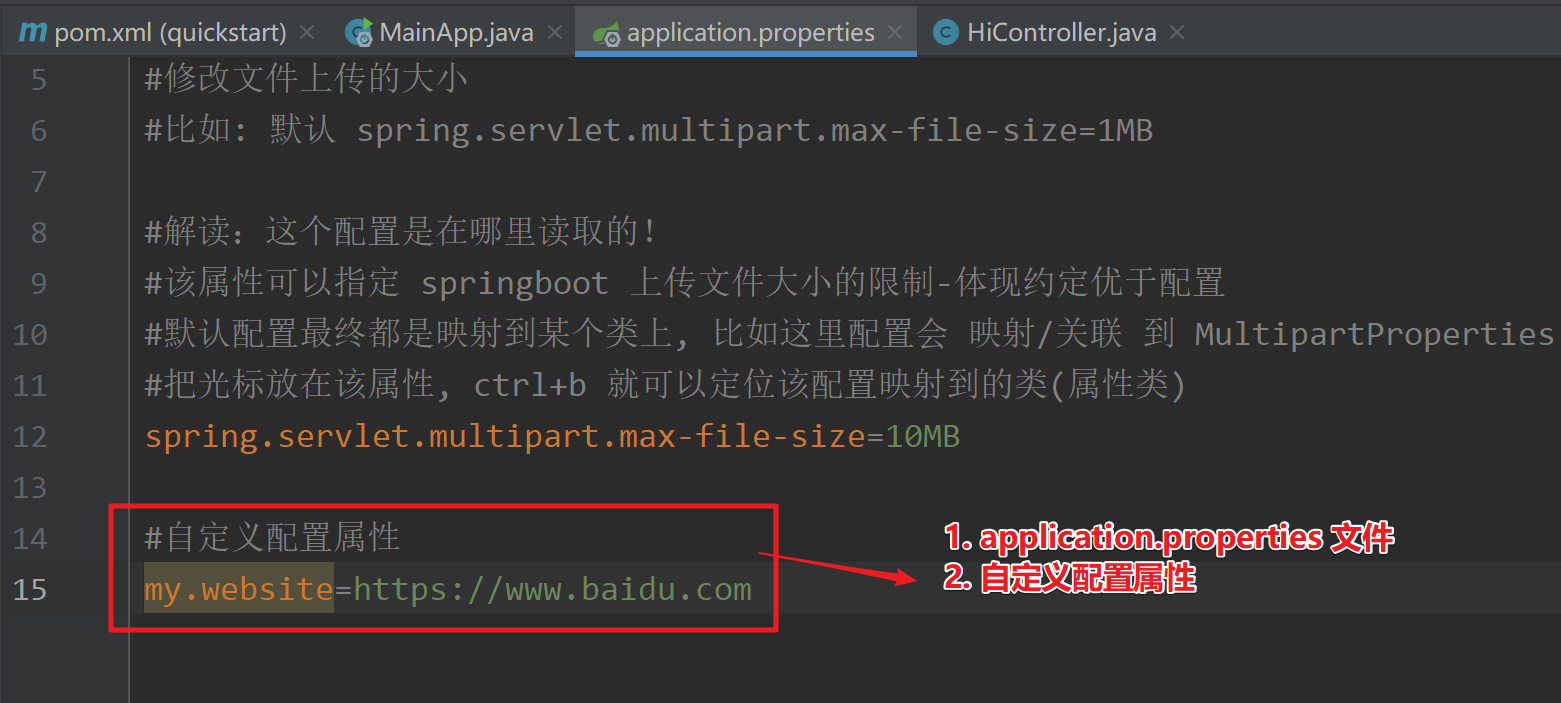
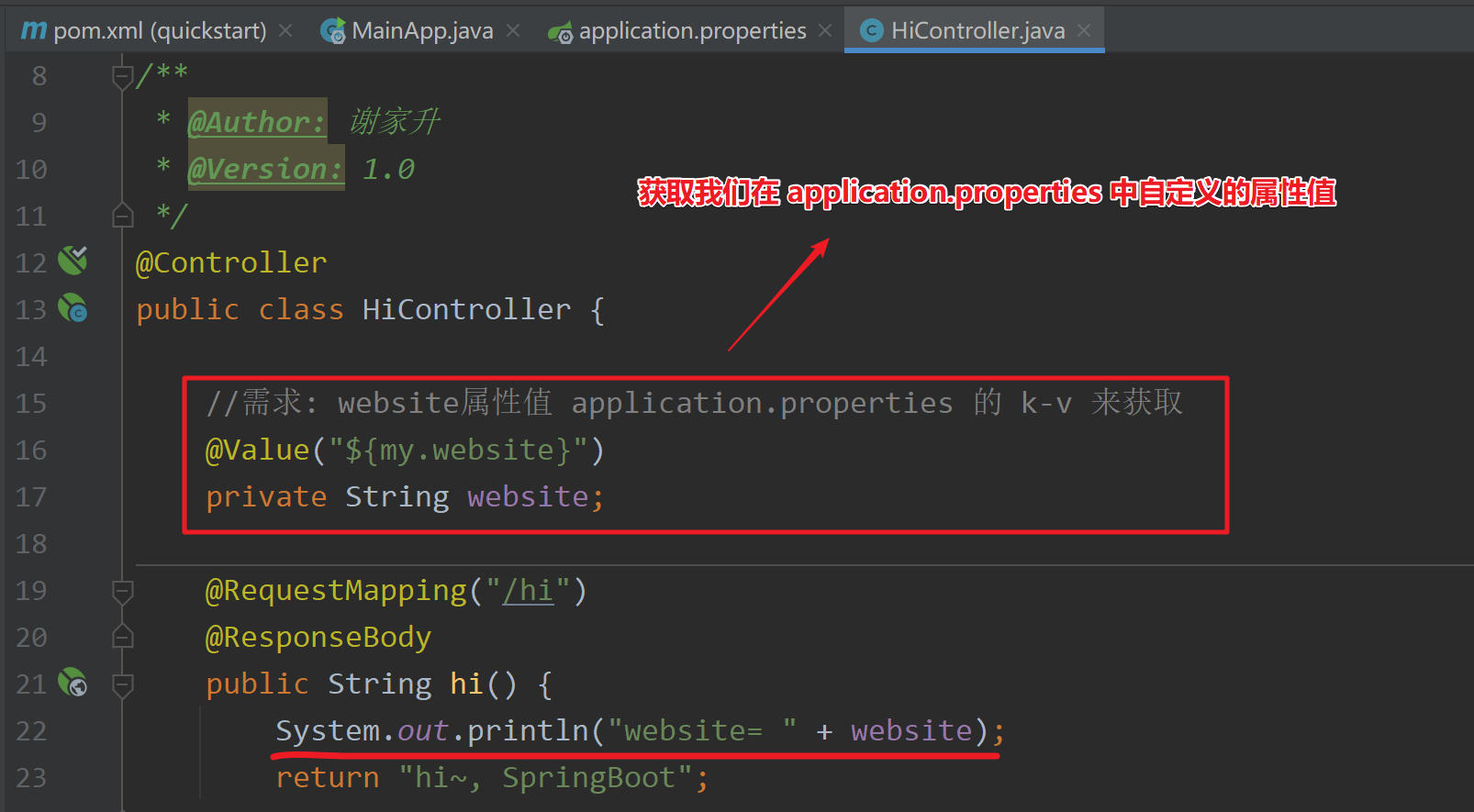
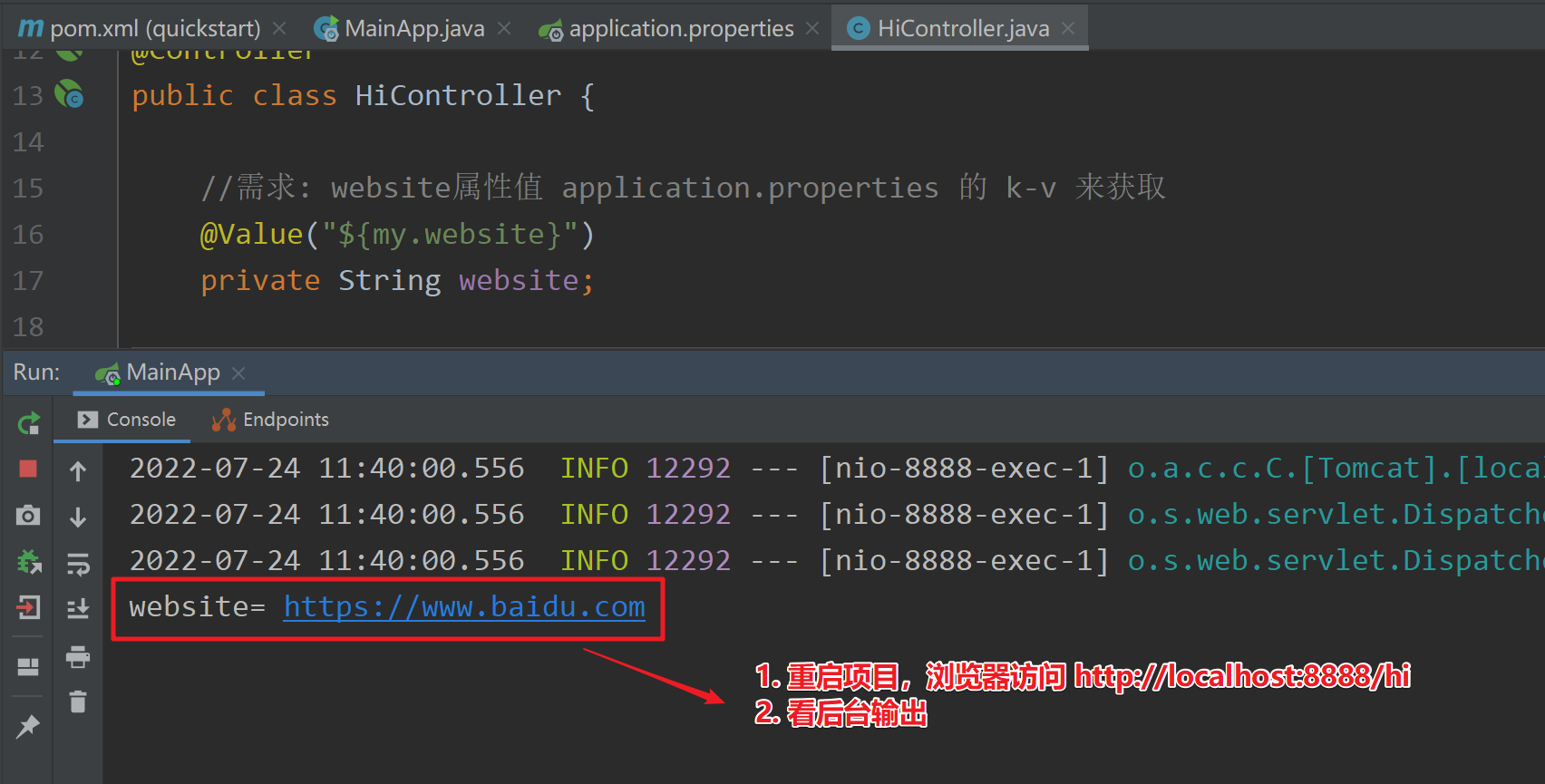
2.3.4 SpringBoot 在哪配置读取 application.properites
- 打开 ConfigFileApplicationListener.java ,看一下源码
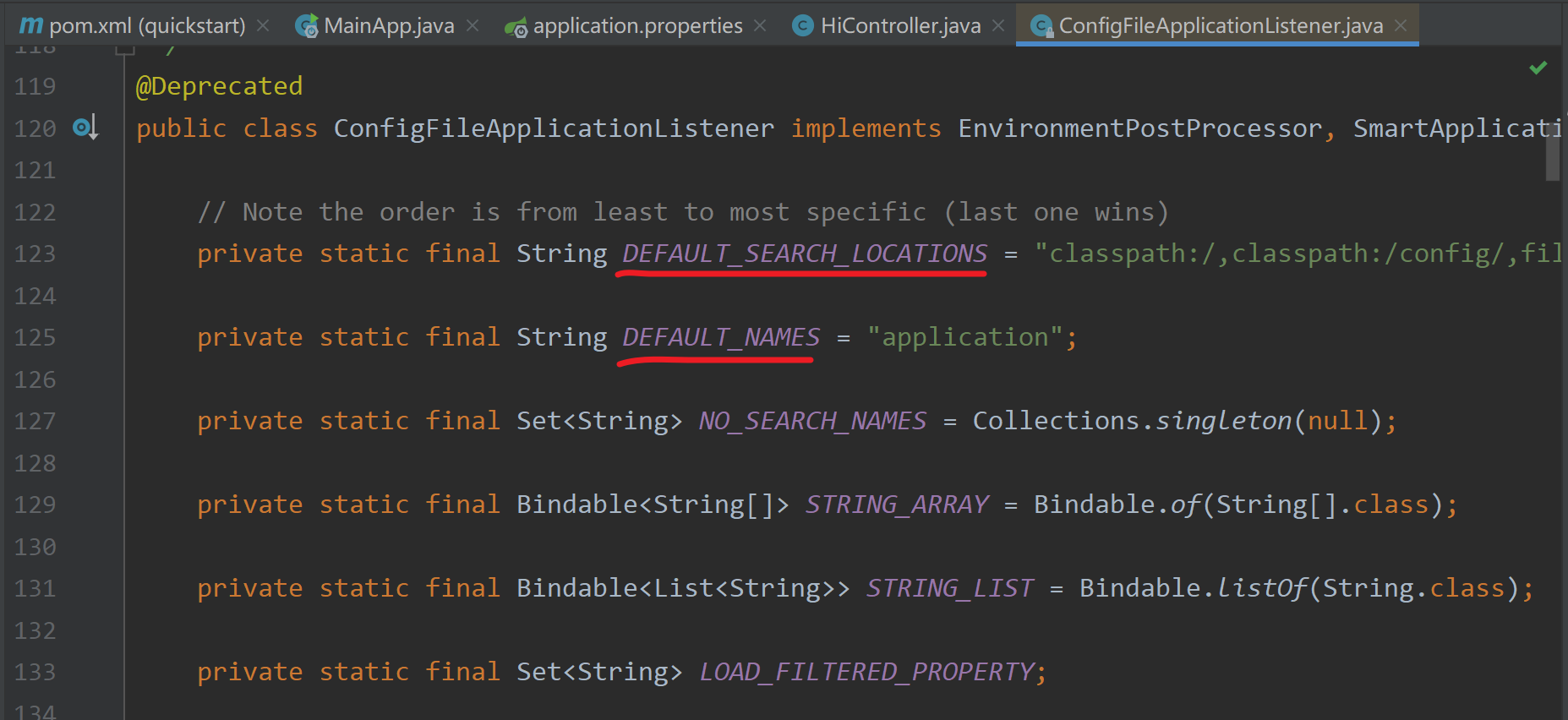
@Deprecated
public class ConfigFileApplicationListener implements EnvironmentPostProcessor, SmartApplicationListener, Ordered {
// Note the order is from least to most specific (last one wins)
//Here you can see what the default paths are,其中 file表示项目的根目录
private static final String DEFAULT_SEARCH_LOCATIONS = "classpath:/,classpath:/config/,file:./,file:./config/*/,file:./config/";
private static final String DEFAULT_NAMES = "application";
//...
}
2.3.5 自动配置 遵守按需加载原则
2.3.5.1 基本说明
- 自动配置遵守按需加载原则:也就是说,引入了哪个场景 starter 就会加载该场景关联的 jar 包,没有引入的 starter 则不会加载其关联 jar
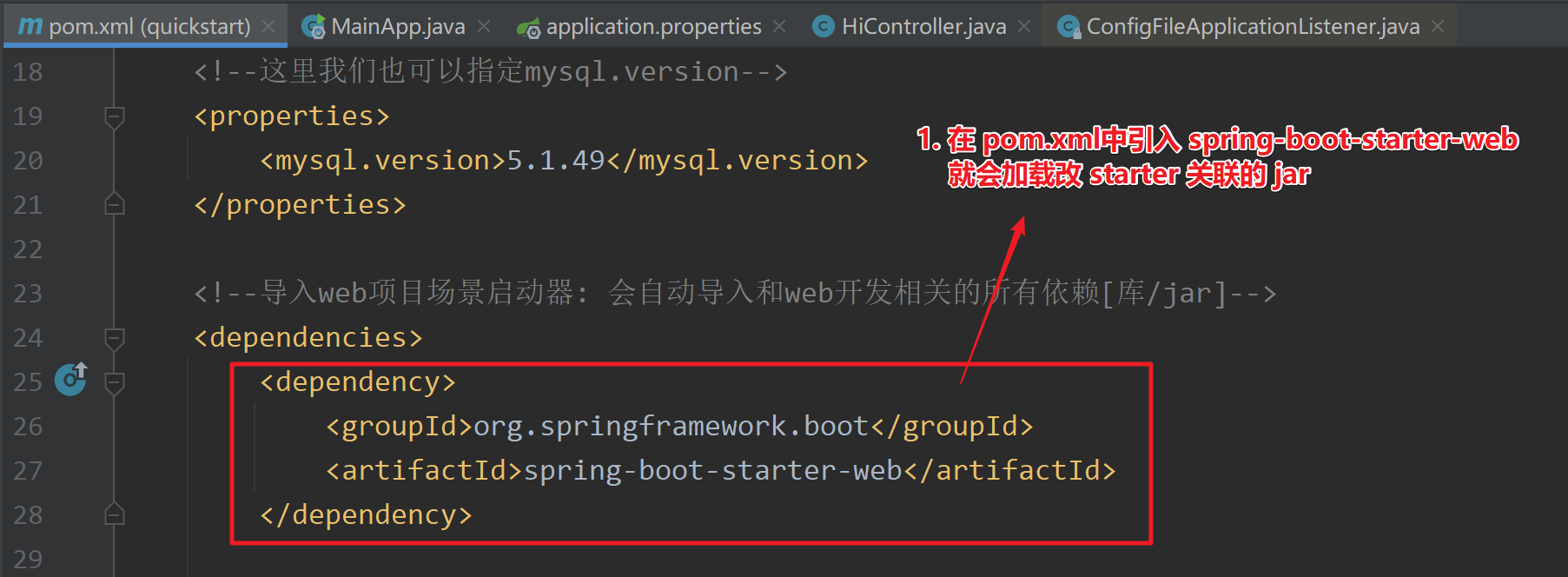
- SpringBoot 所有的自动配置功能都在 spring-boot-autoconfigure 包里面
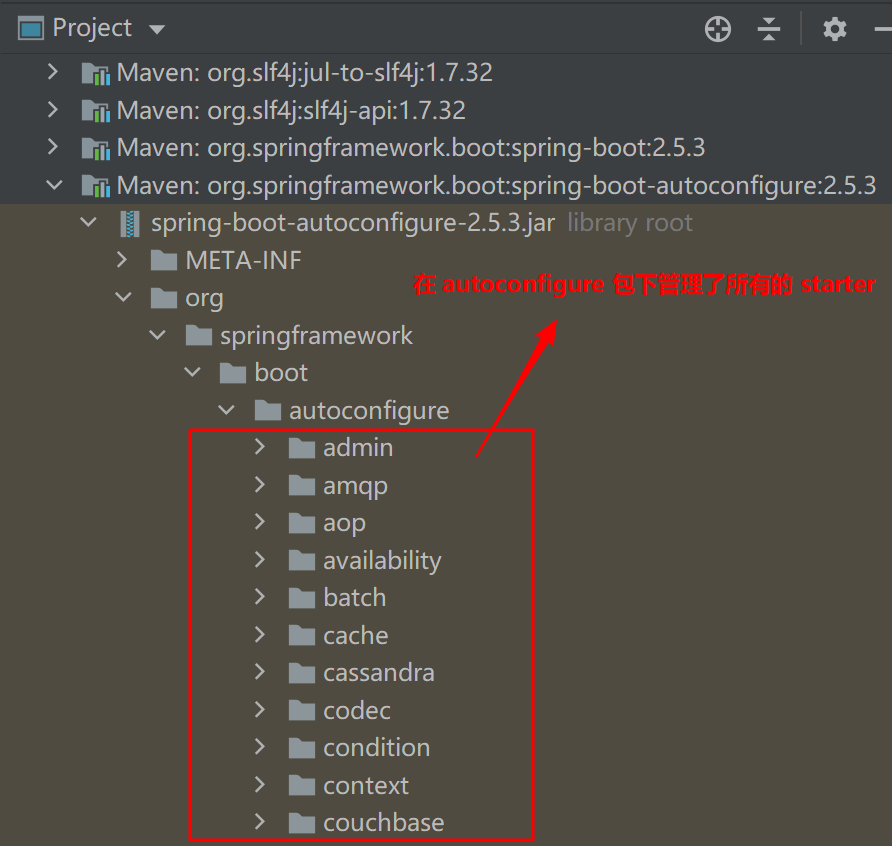
- 在 SpringBoot 的自动配置包, 一般是 XxxAutoConfiguration.java,对应 XxxxProperties.java,如图
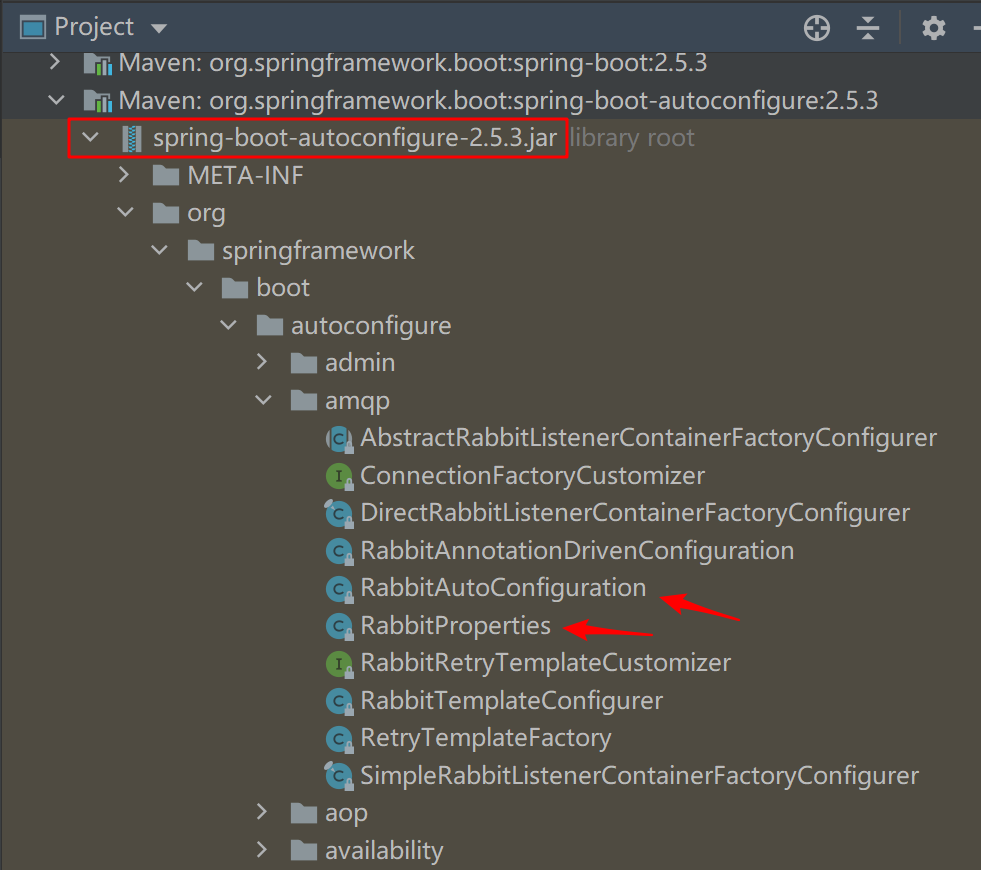
2.3.5.2 实例演示
- 以 MultipartProperties ,MultipartAutoConfiguration 和 application.properties 来说明
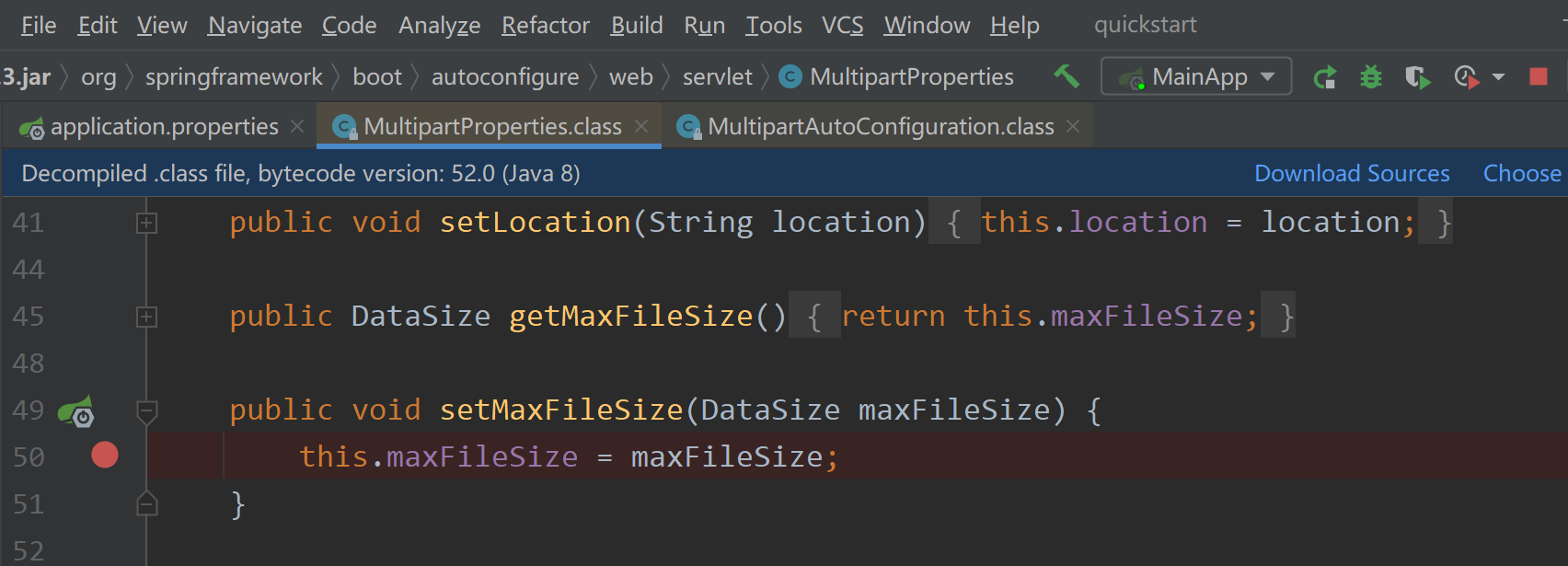

------看下iocThe reference relationship of the singleton pool------
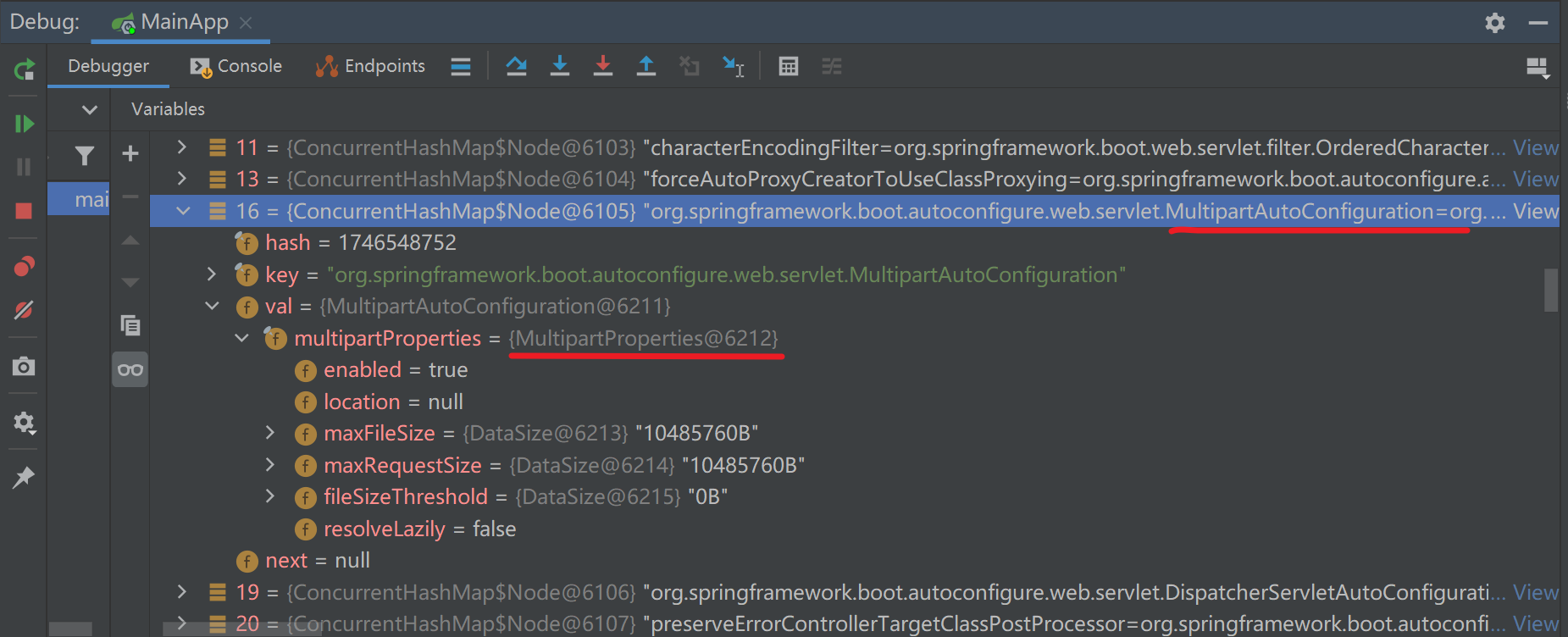
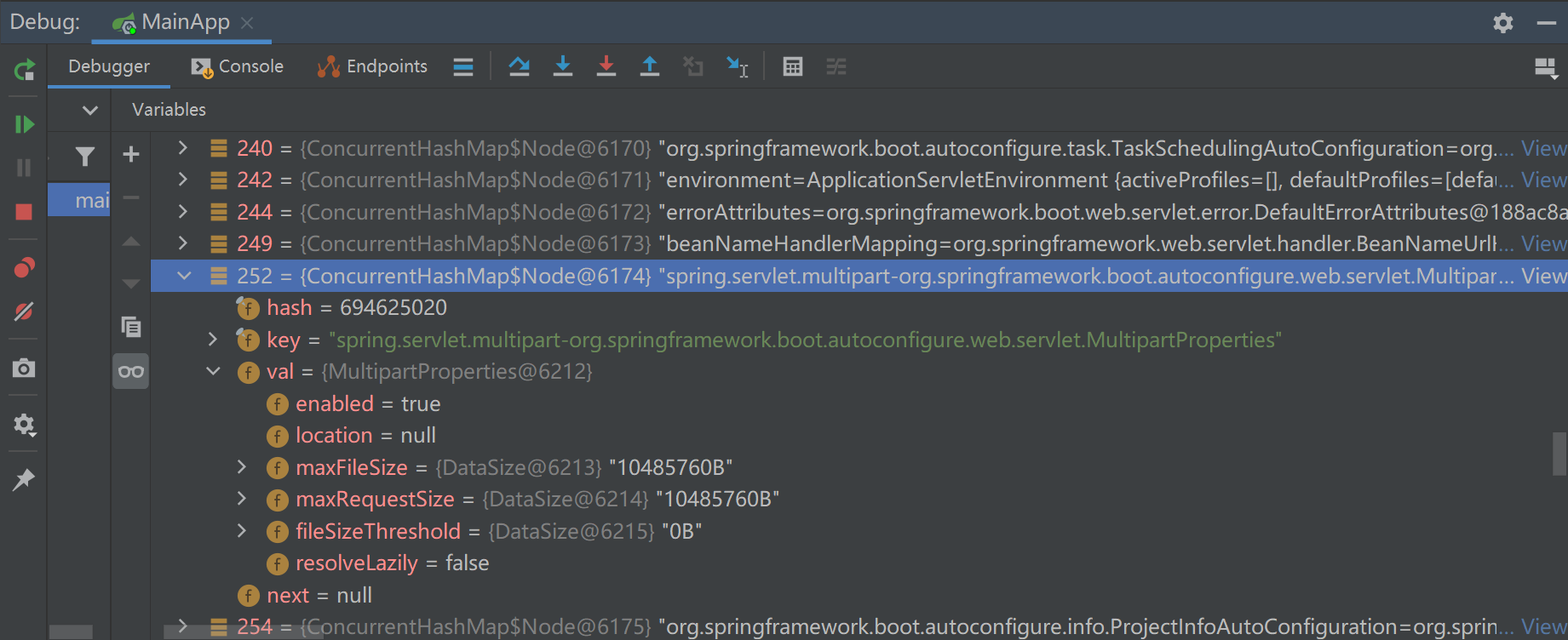
边栏推荐
- 卷积神经网络CNN详细介绍
- Blue Hat Cup 2022 web/misc writeup
- SAS数据处理技术(一)
- Talking about jsfuck coding
- Which translation software is more accurate [Free]
- HCTF 2018 WarmUP writeup
- App基础优化三部曲:启动原理&黑白屏优化&启动时间优化
- 安科瑞为工业能效行动计划提供EMS解决方案-Susie 周
- 【C语言】猜数字游戏的实现
- Microsoft: Into Focus with Scott Guthrie Scott Hanselman Rajesh Jha and Kevin Scott | KEY11
猜你喜欢
随机推荐
宝塔实测-搭建PHP在线模拟考试系统
C language% (%d,%c...)
ROS实验笔记之——UZH-FPV数据集的验证
HFCTF 2021 Internal System writeup
花环灯问题
基于SSM实现手机销售商城系统
8. WEB 开发-静态资源访问
开源一夏|OpenHarmony如何选择图片在Image组件上显示(eTS)
如何判断一个数为多少进制?
Metasploit——客户端渗透
HGAME 2022 Final writeup
一文带你了解 ViewModel 的使用及源码解析
promise详解
互联网中不可缺失的网络优化:“App与Server的交互依赖于网络”
u盘数据不小心删除怎么恢复,u盘数据删除如何恢复
How to recover data from accidentally deleted U disk, how to recover deleted data from U disk
【C语言】二分查找(折半查找)
MySQL数据库基础操作
推进牛仔服装的高质量发展
HGAME 2022 Week3 writeup

